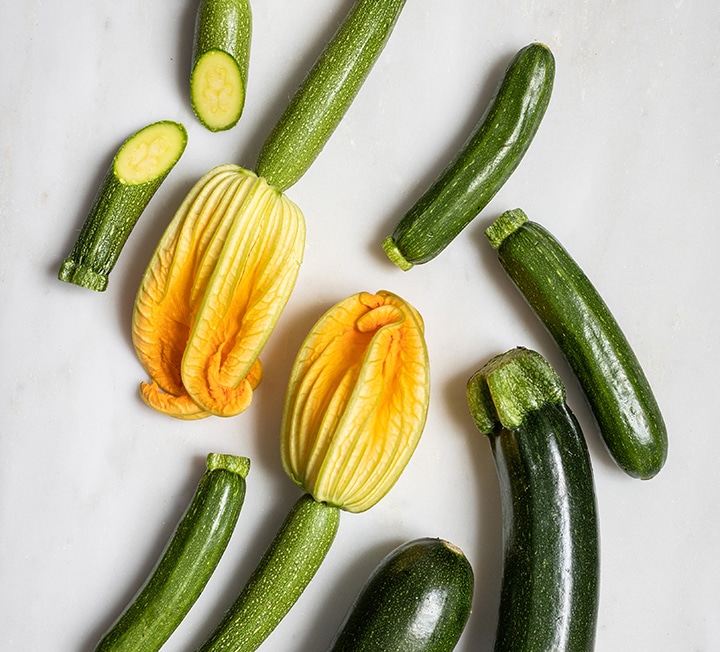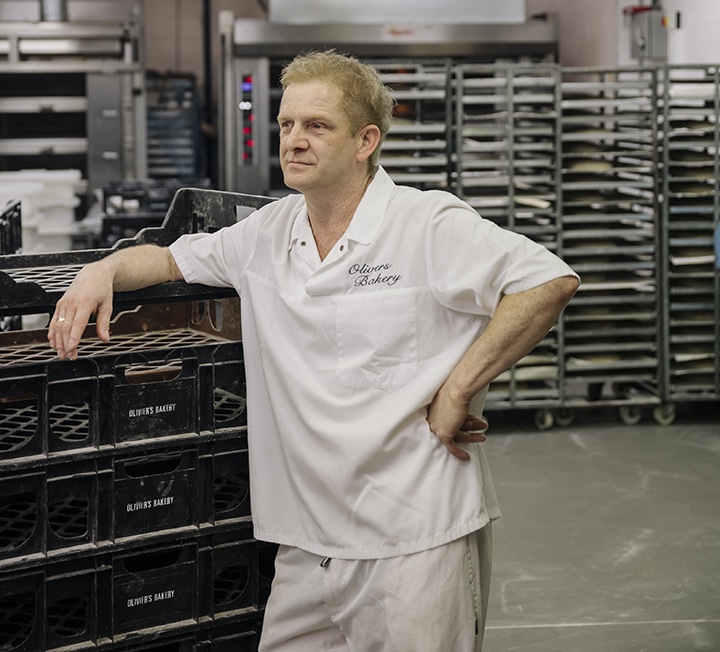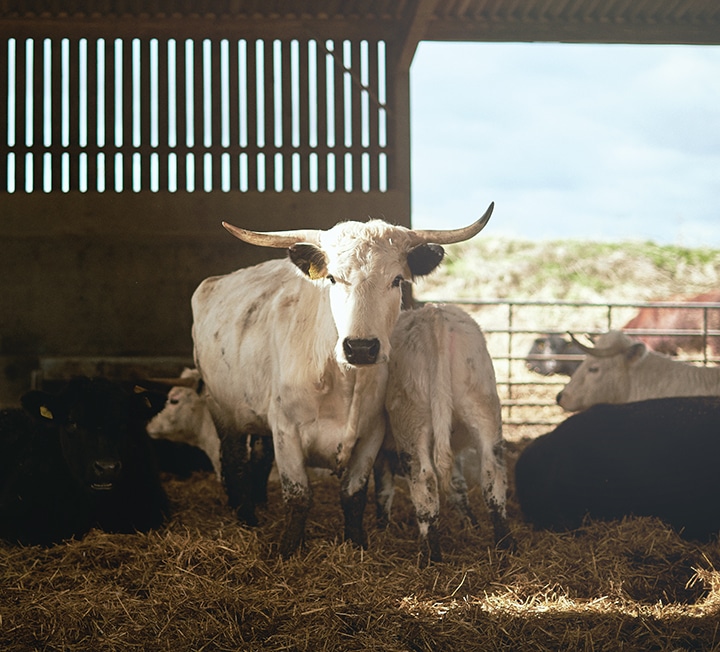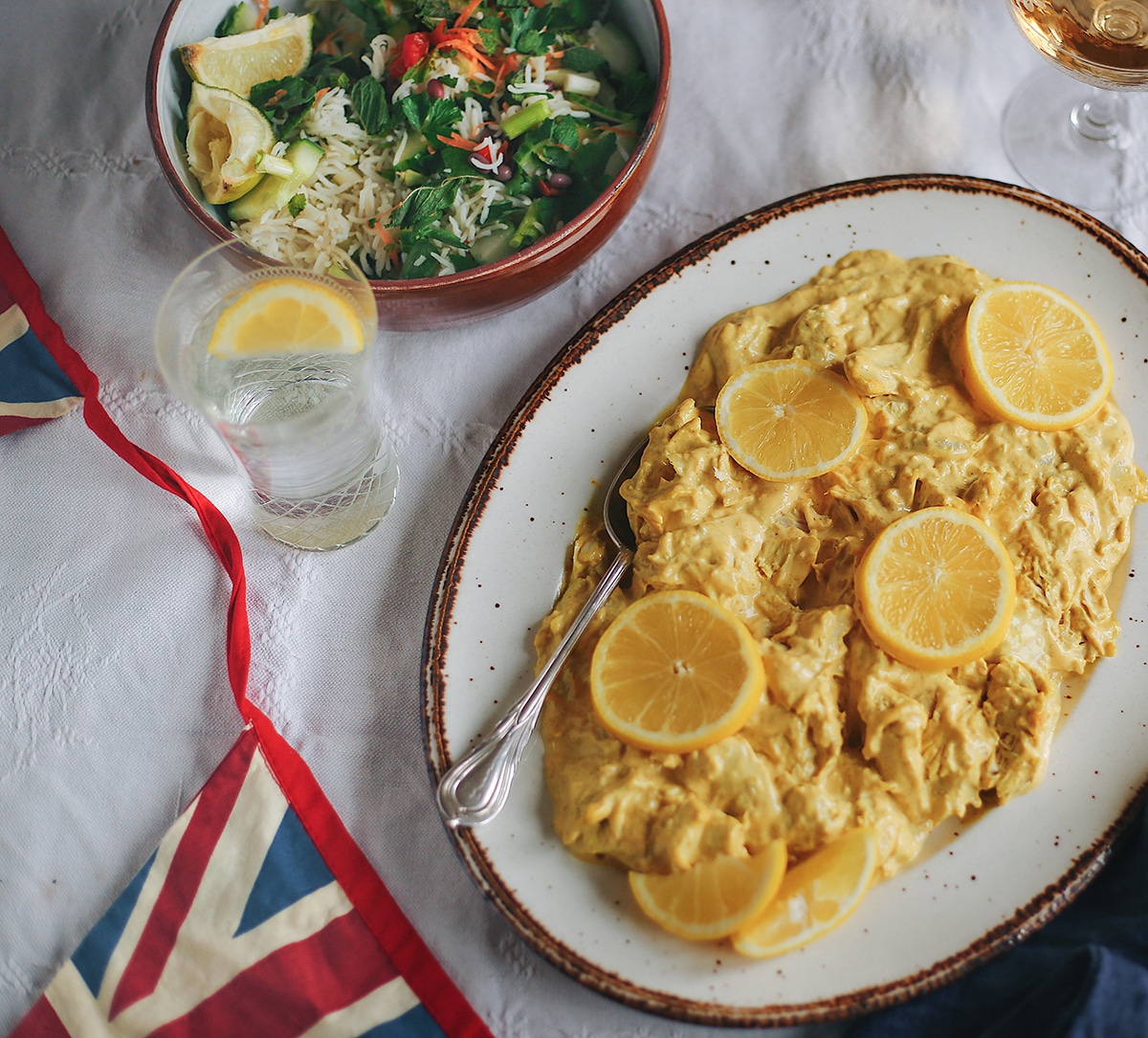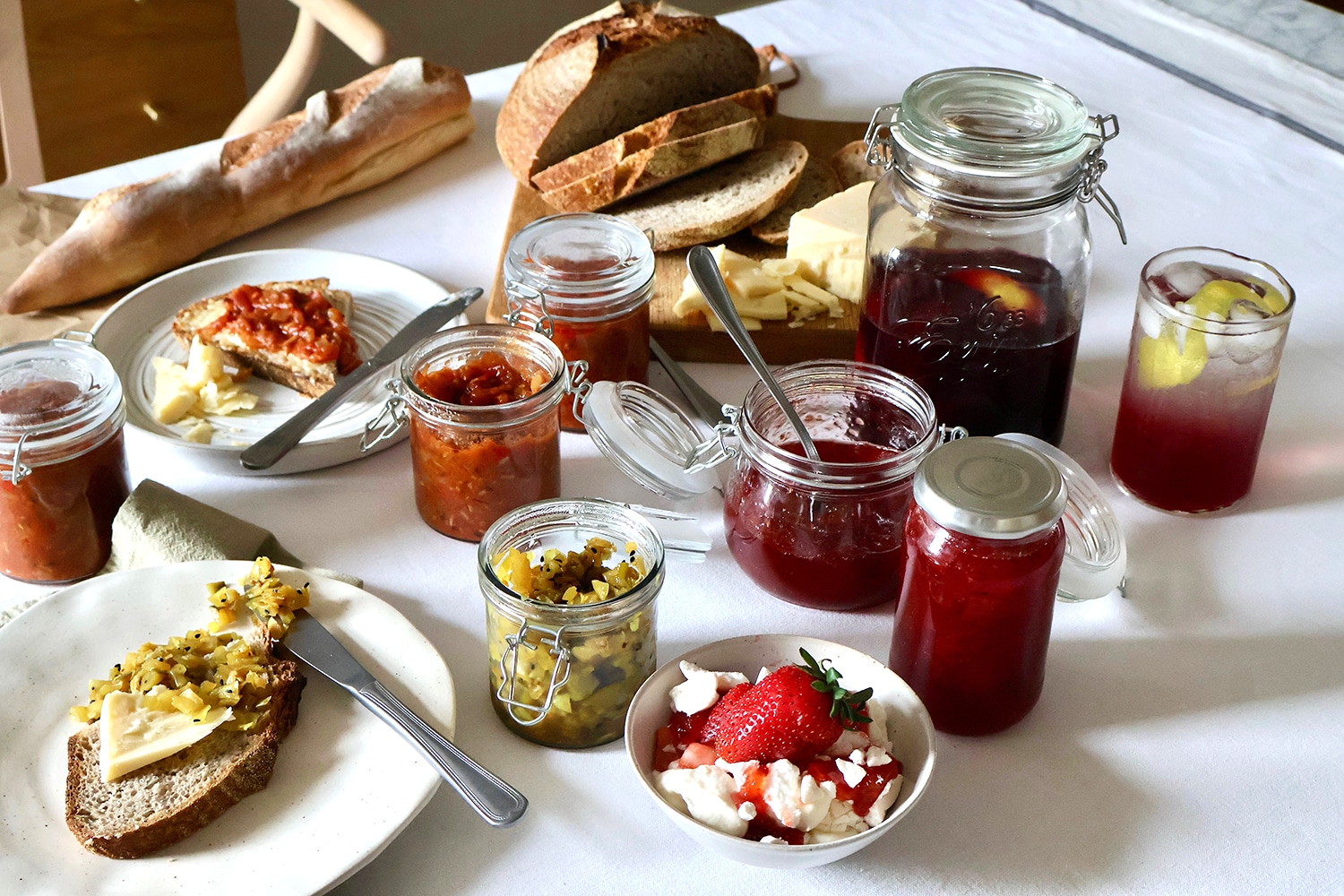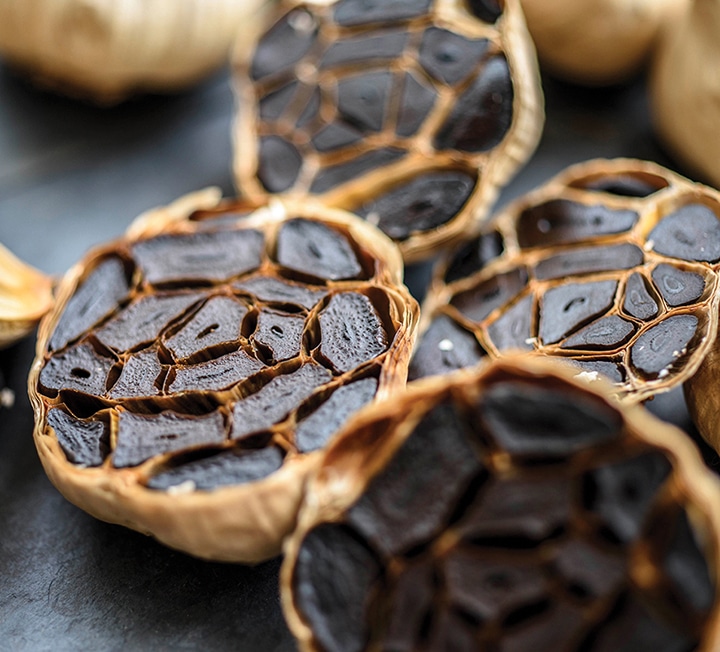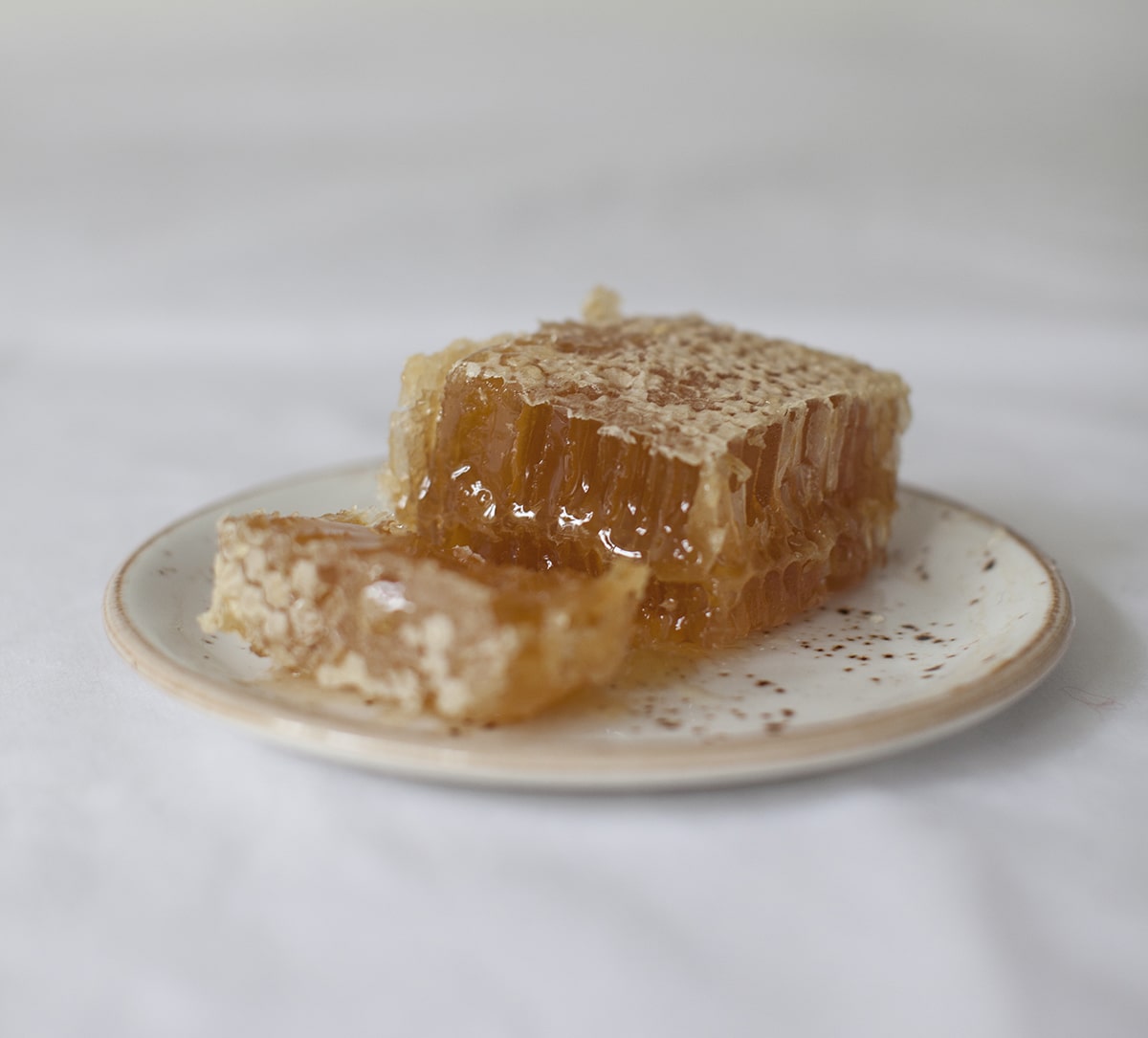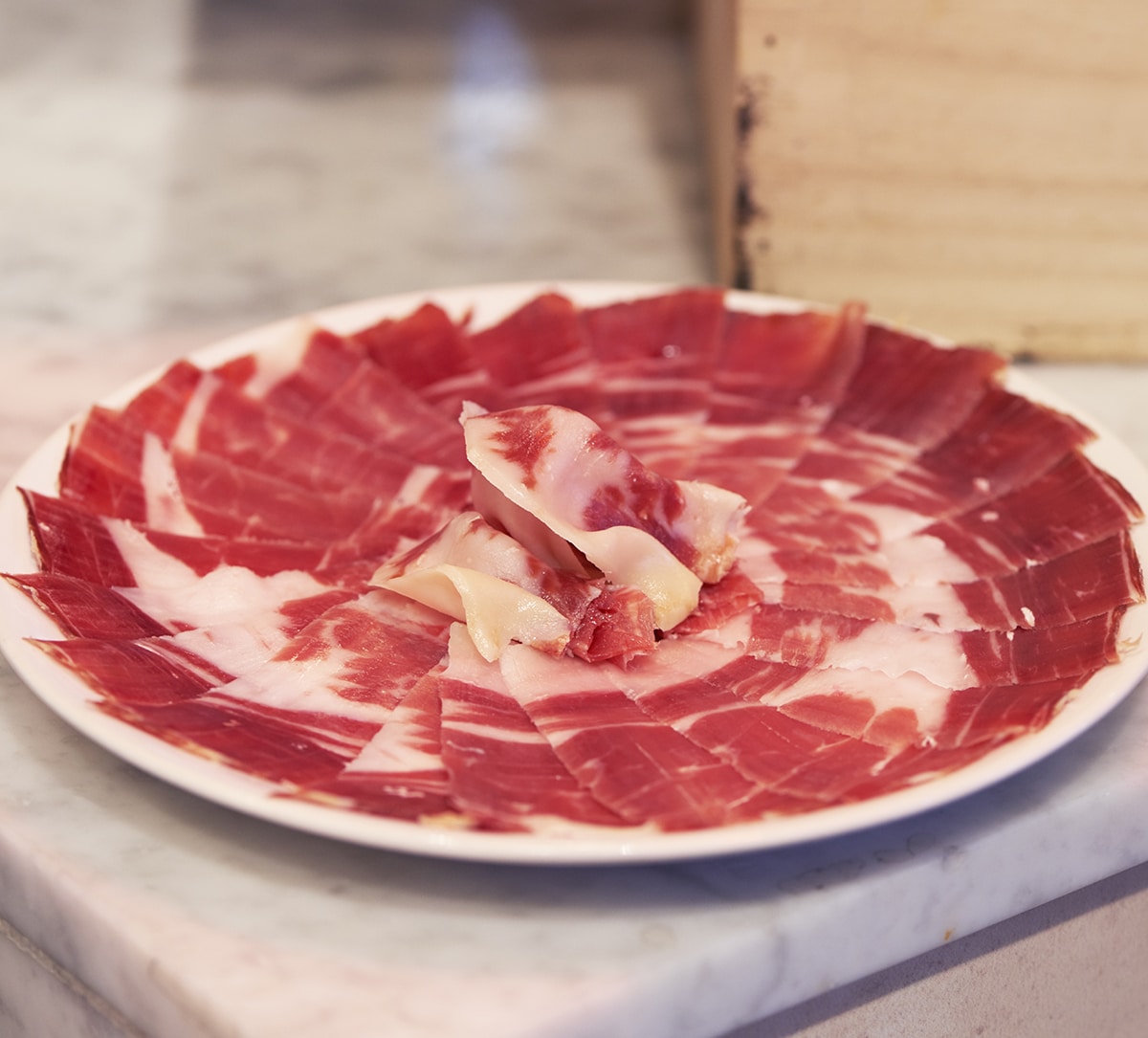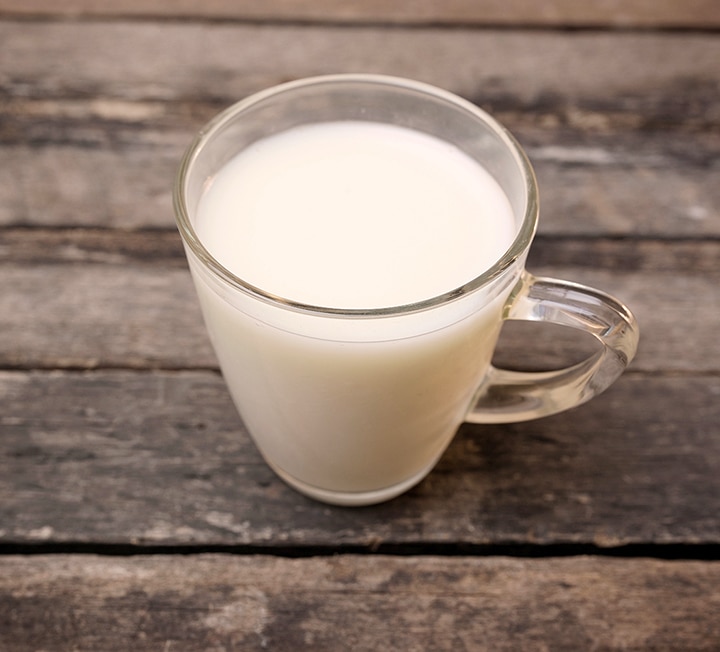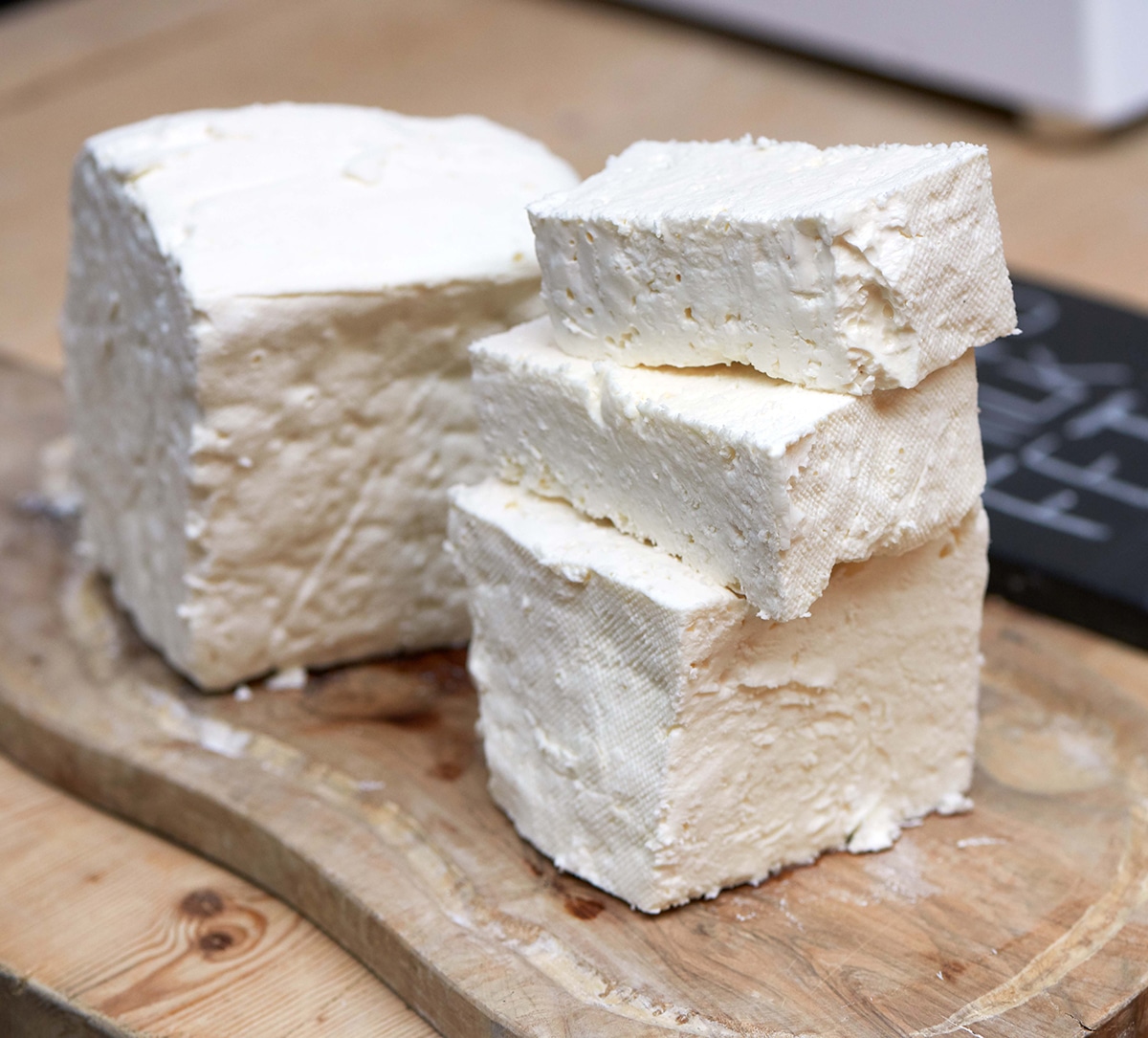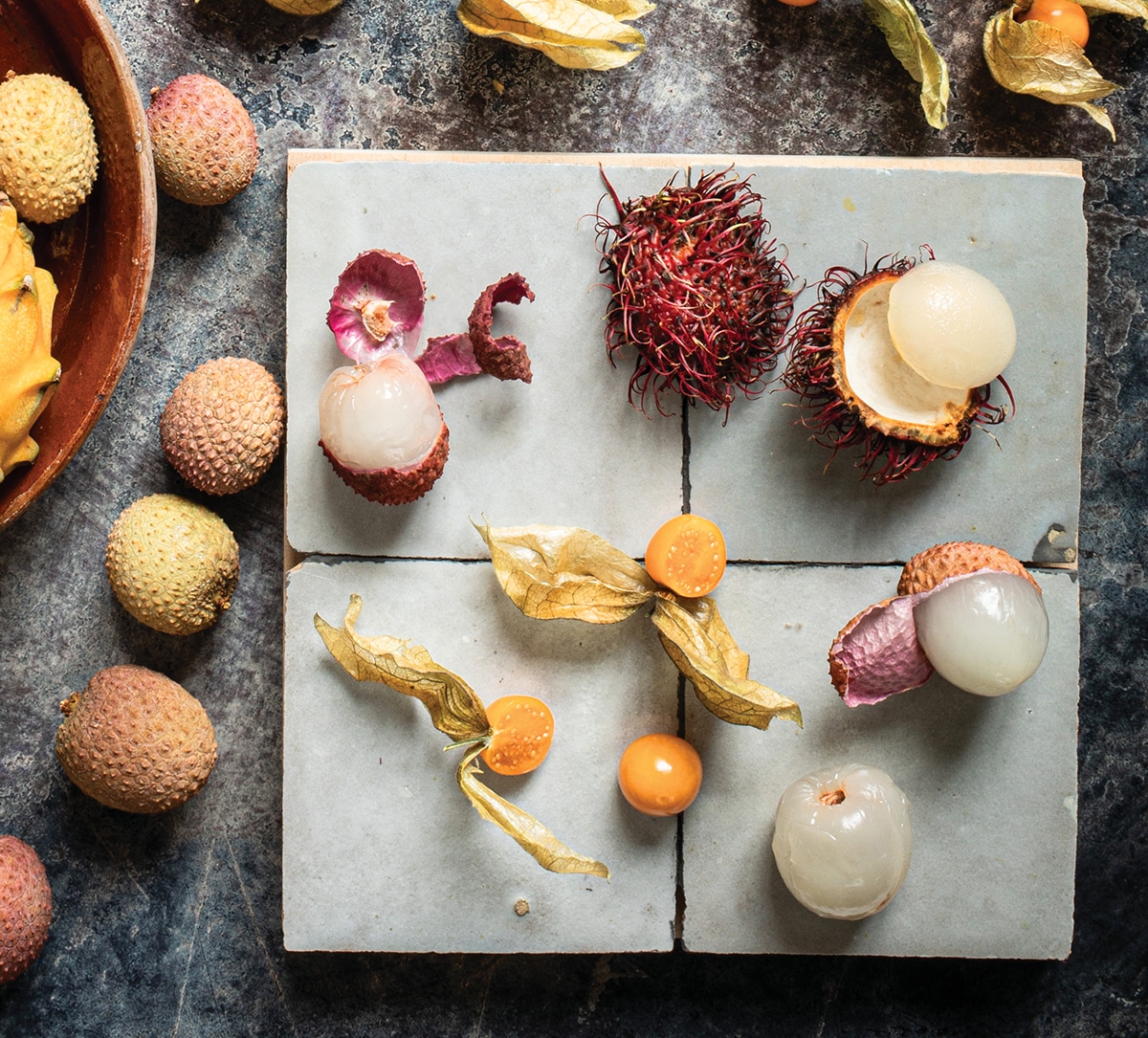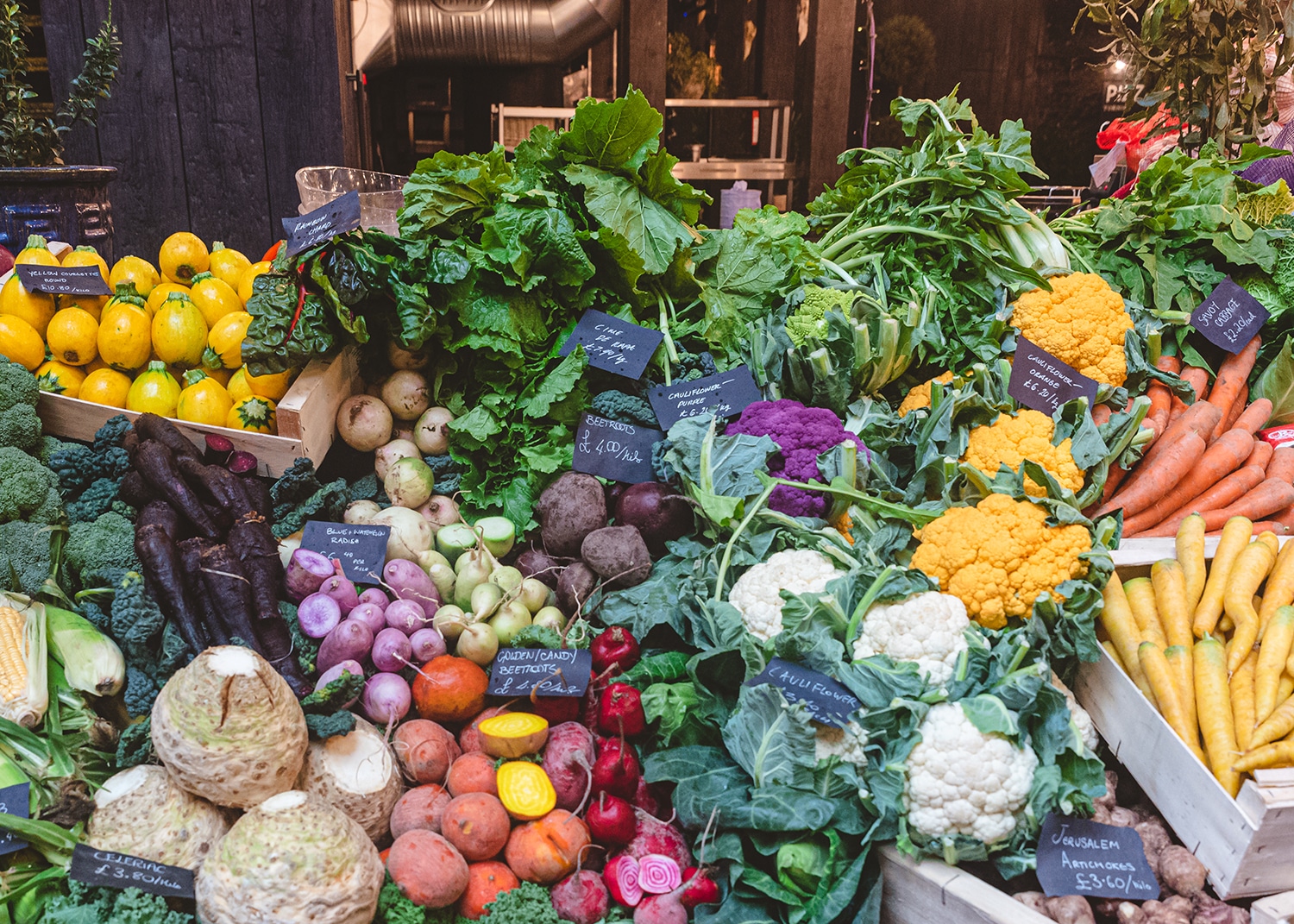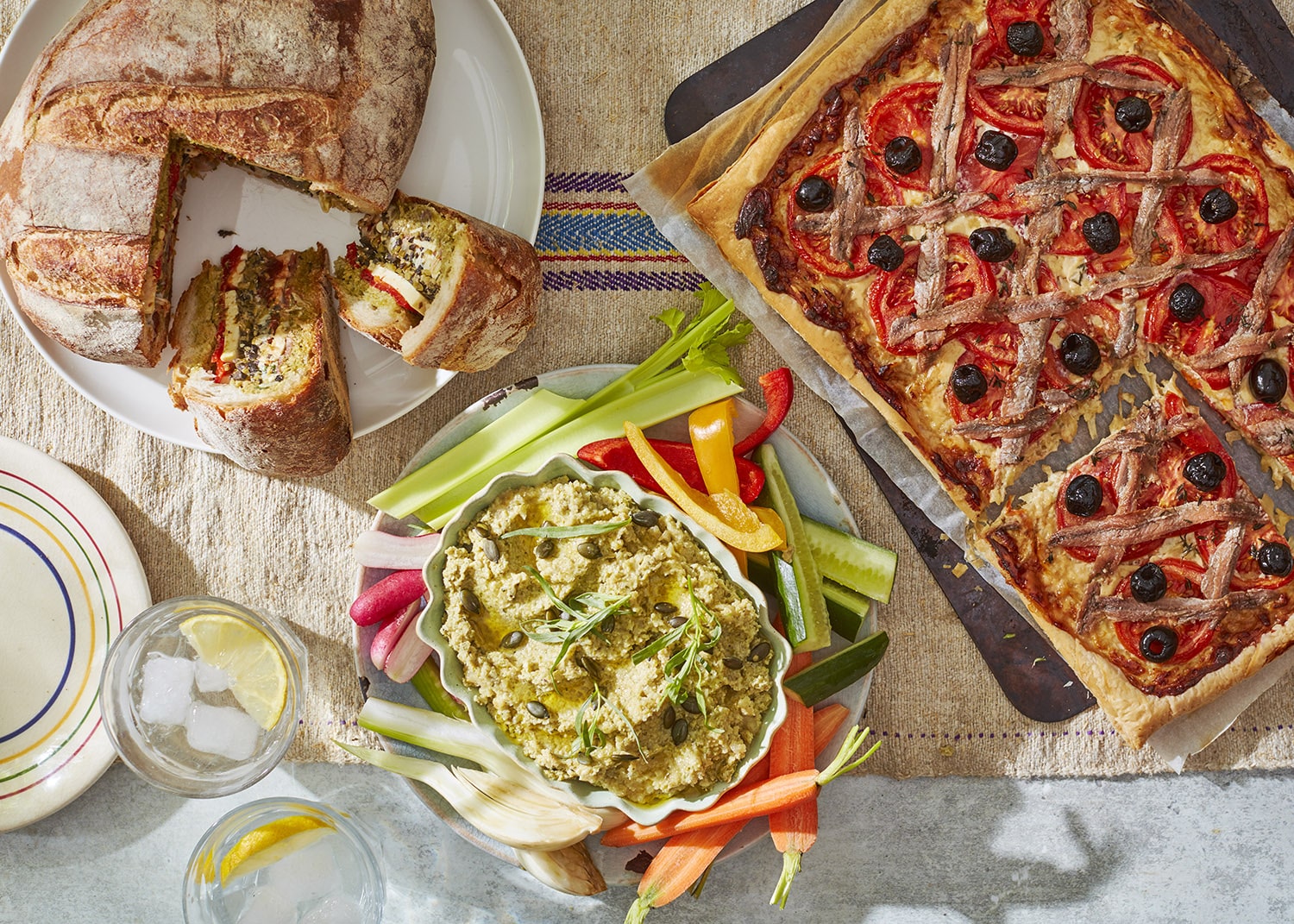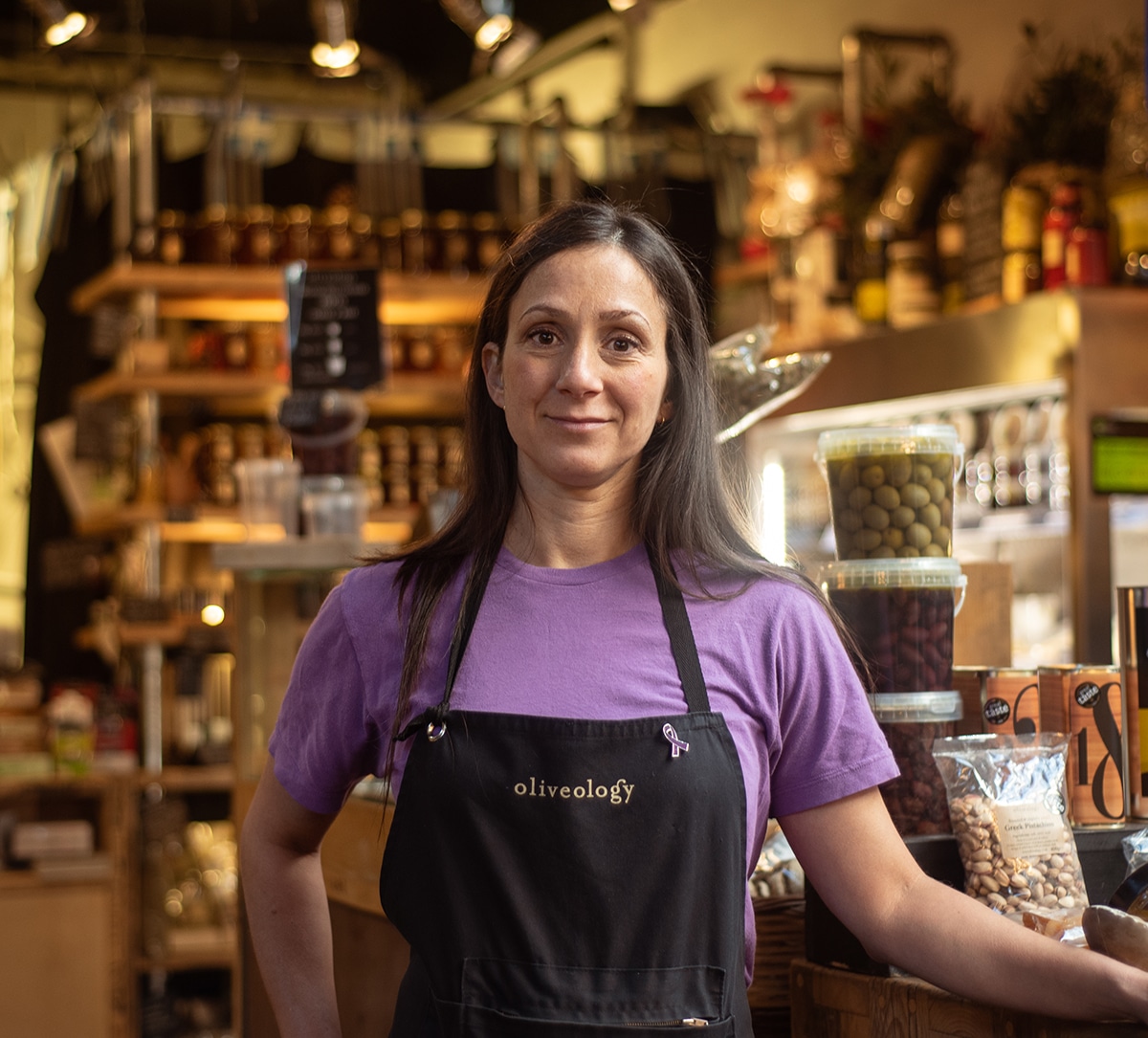Drinks all round
To mark Pride month, Aimee and James from The Cider House on how Borough’s cider bar is a haven of inclusivity


“IT FEELS LIKE WE HAVE ALLIES EVERYWHERE AND THAT’S WHAT MATTERS MOST. WE CAN JUST BE OURSELVES, ALL THE TIME”
Interview: Mark Riddaway
The Cider House is Borough Market’s specialist cider and perry bar, offering drinks on draft and bottles of every kind, to drink at the Market or take home. Most of the ciders are English, but the increasingly wide world of cidermaking is strongly represented, with brews from Scotland, Wales, the United States, France, Ukraine, and anywhere else that apple mulch is turned into beautiful booze. And it’s not just The Cider House’s range of bottles that is colourfully diverse, as the stall’s co-managers Aimee and James can attest.
We’re speaking during Pride month. Why is that of particular importance to you at The Cider House?
Aimee: A lot of us in the business, me included, are part of the LGBTQ+ community. I’ve worked in the drinks industry for a while now and it can be hard, because traditionally it’s been very straight, very white, very cis male. But drinks are for everybody. Cider is for everybody. When I got the job here, one of the reasons I was instantly very into it was that I knew I could just be who I am, without having to compromise or change, without having to fit into a mold.
James: I think because we’re so diverse – across the range of ethnicities, and across the LGBTQ+ community, myself being trans and gay – we’re able to offer an inclusive face for people who want to try new things but might feel a little intimidated. We’re able to put the message out there that there’s much more to cider than just a pint of Strongbow in a pub and that the people behind the fine cider movement are as diverse as the drink itself. We want everyone to feel comfortable – customers and staff alike.
It’s easy to presume that in years gone by the cider world would have felt quite blokey and conservative. Is that changing?
James: It has changed a lot in the past five years or so. I feel like we’re at the beginning of an upswing similar to one that craft beer went through about 10 years ago. Craft beer became this huge, diverse, inclusive market, where before it had been quite a blokey thing; now the same is happening with cider. It’s no longer just something that men in Somerset make. It’s a huge industry that employs people of all genders, all ethnicities, all sexualities. We have ciders made by people in the queer community, by women, by men, the whole range. Anyone can make cider, anyone can enjoy cider, and that’s what we want to showcase at The Cider House.

Beyond your stall, does Borough Market feel like an inclusive place to you?
Aimee: Everybody’s so lovely here. It’s weird, because we’re all part of Borough Market, but we’re all in separate businesses. And even though we’re all doing different things, somehow we’re all really similar. There’s this real sense of togetherness. It feels like we have allies everywhere – the traders, the management, the lovely security team – and that’s what matters most. We can just be ourselves, all the time, which is the reason I love working here so much.
James: I have to say, when I first got the job here, I was a little wary of what the Market community would be like, but I felt comfortable straight away. Then the first time I saw the Pride flags go up and the posters saying this a place for everybody, it made me feel even more at home in my workspace. Sometimes being LGBTQ+ can feel a little isolating. When the people in your workspace, the place you spend most of your days, are so open about their support, that’s a huge thing.
For all the progress that has been made, intolerance still thrives in our society. Do you ever experience it yourselves?
James: I haven’t found direct prejudice towards my sexuality or gender in public places. It’s more on social media these days. People find it easier to say mean things when they’re not saying it to your face. They like to hide behind their screens. It’s definitely on social media that the biggest amount of progress still needs to be made.
Aimee: I made a Pride post for our Instagram, and because the Market team collaborated with me on it, it reached a lot of people. We had a lot of amazing comments, but we did have a nasty comment from someone. Borough Market instantly hid it, which was great. They were like: “No, we’re not having that. Gone.” When you surround yourself with people who are so supportive, you forget that intolerance still exists, but it does, and it probably always will. It’s just about being louder than them. It’s about inclusivity being louder than intolerance.
It’s London Pride on 1st July. What will you be doing to mark the occasion?
James: I’m going to pop over after my shift. I’m really looking forward to it. It’s great to celebrate who we are, unapologetically. That’s the whole point of Pride, I think.
Aimee: At The Cider House, we try to be as proud as we can every single month of the year, but this is a time when we can be really visible, feel really accepted, and celebrate how far we’ve come. On that Saturday, it’ll be like we’re having our own little Pride parade. Given how slowly people walk through the Market on a Saturday, it’s basically always a parade!
A moveable feast
Food writer Leah Hyslop on what to pack for the perfect picnic


“LEAF SALADS ARE A NO-NO: AS REFRESHING AS A BIG PLATE OF GREENS MIGHT SEEM, THEY WILT AS SOON AS YOU LEAVE THE HOUSE”
When I was a child, I loved Enid Blyton’s Famous Five books, but it wasn’t the escapades with smugglers and kidnappers that I gobbled up with the most enthusiasm, it was the descriptions of food and in particular, the picnics – fat tomato sandwiches, boiled eggs, buttery homemade shortbread, ginger beer and always, always “a screw of salt” to bring the food to life.
I couldn’t imagine anything better than sitting among the grass with friends, eating such a feast. And I still feel the same way today. In this blustery, rainy country, there is something so joyous about eating outdoors – and for the keen cook, there’s a delicious challenge in working out how to create the perfect spread.
The test, of course, is working out what foods can withstand the multiple trials of being taken on a long journey; thrown about in a bag or hamper; sitting out in sun for hours; and/or being sat on by small children. For this reason, leaf salads are a no-no: as refreshing as a big plate of greens might seem, they wilt as soon as you leave the house. Instead, pack chunky crudités like carrot sticks or celery with homemade dips, or boxes of roasted veg. Dressings should be carried separately and mixed in just before you eat.
Sandwiches are a picnic mainstay, though they can be a bit soggy by the time you’ve found the perfect spot with shade/sun/proximity to pub. I love stuffed picnic loaves, partly because they’re very robust, but also because they are such fun to make. Simply take a big round loaf, slice off the lid, and hollow out the inside. Then stuff it with layers of your favourite ingredients, like cheese, olives and ham (this is a brilliant use for all those delicious antipasti sold at Borough Market). Put the lid back on top and squash down for a few hours with some heavy tins, before taking to the picnic and slicing for everyone to enjoy.
There are picnic fanatics who spend days designing their dream al fresco menu. Victorian cookery writer Mrs Beeton wrote that for her ideal picnic, one should prepare “a joint of cold roast beef, a joint of cold boiled beef, two ribs of lamb, two shoulders of lamb, four roast fowls, two roast ducks, one ham, one tongue” – plus stewed fruit, biscuits, fruit turnovers, “four dozen cheesecakes” and a plum pudding. But I’m a firm believer that you should keep picnic food simple, and delicious; after all, your plans could so easily be ruined by the not-so-great British weather.
Simplicity is especially important when it comes to dessert, by which point I find most people just want a quick dose of sugar before they go off to play frisbee. I like to fill some glass jars with a sort of deconstructed cheesecake: layers of sweetened cream cheese, a quick coulis and fruit with crumbled brownies or cookies bought from one of Borough’s bakery stalls.
Re-using old jars is just one of the ways you can make your picnic as environmentally friendly as possible. Avoid paper plates and plastic knives and forks if you can – a picnic feels better with proper plates and cutlery anyway, even if you don’t have a posh hamper. Beeswax wraps are a smart re-usable alternative to clingfilm, and it’s also worth planning foods that don’t need too much disposable wrapping. I like to make a filo pastry and salmon pie in a tin that I can take to the picnic in the tin itself (just cover the top with another tin base or a tea towel).
A delicious homemade drink turns a good picnic into a great one. In June and July, try putting the under-appreciated British gooseberry to good use in a refreshing gooseberry lemonade, or make homemade iced tea, a drink that can be customised for the grown-ups with a splash of gin, which never goes amiss. But avoid packing anything too alcoholic – think thirst-quenching rather than something that will give you a hangover by 3pm. After all, if you’re lucky and the sun is shining, you might be out picnicking for hours. That’s what the Famous Five would have done.
The heart of the matter
Clare Finney’s new book, Hungry Heart, explores the connections between food and the many forms of love. Borough Market, a place that taught her to see food as something more than sustenance, was central to its conception


“INTERVIEWS WITH BAKERS, BUTCHERS AND CHEESEMAKERS, EXPOSED ME TO THE PASSIONS THAT DRIVE PEOPLE TO MAKE FOOD”
People who have done both will occasionally remark that writing a book is akin to having a baby. I’m yet to experience motherhood so am not best placed to judge, though I will accept that creating a book renders you similarly incapable of thinking or talking about anything else for quite a while.
Where the two definitely differ, however, is in their inception. Unlike a child, there is rarely one clear point in which a book is conceived. They are instead an accumulation and distillation of moments and experiences, some of which feel important at the time, many of which only appear so in retrospect. Like my dad scrambling eggs in the microwave or my briefly dating a man who drank Huel because he was “too busy to chew”.
Working with Borough Market, however, has been one of those experiences that I knew all along to be formative. It is where my food writing career began and where it continues. It is where the seeds of my new book, Hungry Heart, were sown.
From my first trader interview (with Hayleigh from So Chocolicious, I think) to my most recent field trip to the Arbroath smokehouse that supplies Oak & Smoke, the Market has rooted me firmly in its values of community, largesse and sustainability. When I first started working on Market Life magazine in 2012, I was still recovering from the eating disorders that had sabotaged much of my teenage years. It was Borough, its traders and their produce that taught me how food represents so much more than flavour and calories; that a good meal in company of good people sustains our minds and relationships as much – if not more than – it does our bodies.
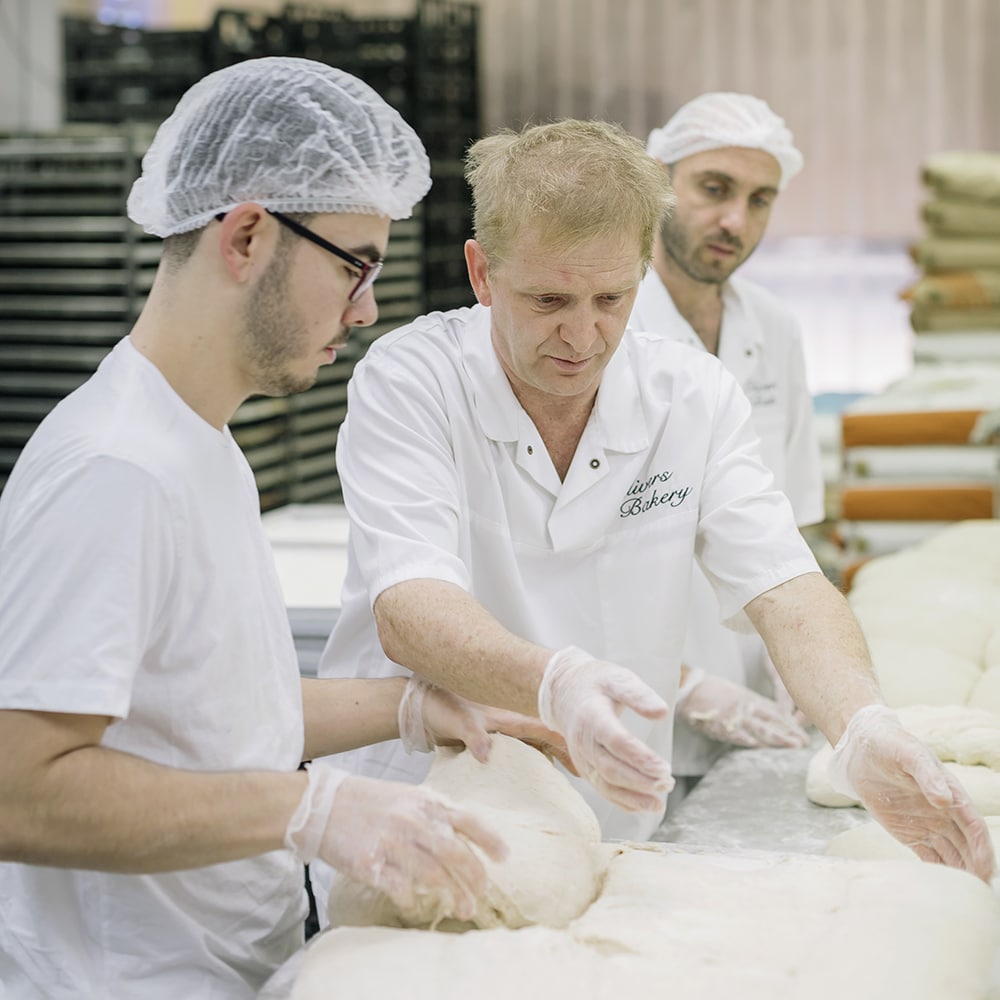
Interviews with cheesemakers, bakers and butchers exposed me to the passions that drive people to make food and drink. To talk to any of these hard-working individuals, who slog away for hours on end, often while most of us are sleeping, is to receive a lesson in life, love and philosophy – be that the curiously intense relationship a baker has with their starter, the mindfulness of cutting and stacking cheese curds, or the respect owed to an Iberico ham leg, expertly cured.
The most philosophical of all the producers I interviewed at the Market was – perhaps unsurprisingly – a French baker, Olivier Favrel of Olivier’s Bakery, whose bakery in Bermondsey I was fortunate enough to visit. I write about that visit in Hungry Heart, about the huge sacks of flour, the ovens, the scent of freshly baked boules, pains au levain and baguettes, of course – and how the one style of bread Olivier refuses to bake is the roll. “Bread is for sharing,” he said. “If you pay attention at dinner or lunch, you will feel a little difference when people pass each other the bread – more than passing the salad, or the salt and pepper. There’s a connection there: in the bread being touched, broken and shared around. There’s no love in an individual roll.”
Indeed, the relationship between bread and love runs deep. I devote a whole chapter to it, during which I recall eating a basket of bread in Paris with my best friend, Lizzie. We’d barely eaten all day and, scraping the last of the butter onto our final pieces of bread, I felt in practice what I’d only known before in theory: that to break bread with friends doesn’t just mean to eat with them. It means to chew over thoughts and experiences. It means to partake in a tradition that transcends countries and cultures, that represents civilisation, conviviality and hope.
The baguette is the quintessence of France and French hospitality. It’s something the French pride themselves on. It connects them – quite literally, in the queue for the boulangerie every morning, and more poetically through the act of sharing. If all Olivier wanted was to make money, he would make rolls, for which he could charge a lot more per unit – but he is content not making much money. He told me he feels rich enough in his wife, young twins, Oscar and Ophelia, and in his customers; and he is constantly struck by the power of baking to bring them joy.
It was also Borough that taught me the importance of process to food and drink – to its production, of course, but also to its consumption. At one point I interviewed a director at Neal’s Yard Dairy, who told me that day by day the team at the company’s Bermondsey headquarters and maturing rooms take turns to cook lunch, then sit down and feast together at the long wooden table occupying the centre of the room. It was vital to how they worked, he said: on a practical level, by boosting communication between different departments, but on a personal level too, by ensuring each employee feels valued and can foster meaningful friendships. The Market is full of such examples of companies and communities forged and reinforced through good food.

A simple lunch lovingly prepared and enjoyed with others cannot compare with a supermarket sandwich eaten alone over your keyboard. A chocolate truffle handmade with Ghanaian cocoa sourced from farmers who can invest in their community will inspire more mindful eating than a Twix between calls. At Borough – and beyond – I learned to slow down and consider food not as fuel but as a fulcrum: the steady, sumptuous beat to which our days, weeks, months and years play out. To understand the value of that precious first cup of tea in the morning, or of plump, perfect ravioli bursting with beetroot, is to understand the value not just of meals, but of all that meals signify: time spent together, the change in seasons, human ingenuity, discovery, familiarity and simple pleasures.
Hungry Heart is not just my story: far from it. There are interviews with friends, food psychologists, anthropologists, even a kitchen designer. I speak to fellow food writers and friends of the Market, like Diana Henry, Bee Wilson and Polly Toynbee; I speak to chefs like Jeremy Lee, and I speak to traders. My story – of my grandparents’ hotel kitchen, my parents’ divorce and the dinners my newly single dad scrambled together with love and a microwave, my parents remarrying and our forging new families around old kitchen tables, my eating disorders and my recovery – is simply the thread that connects this wealth of other stories and creates what is hopefully a universal tale.
As our relationship towards what, when and where we eat becomes ever-more complicated, the time feels ripe to cut through the clutter and ask how food shapes our love for other people and ourselves. Many of the answers can be found at Borough Market.
Hungry Heart: a story of food and love, by Clare Finney (Quarto)
Discover more
Party starters
The Borough Market guide to the ultimate Eurovision party spread


“WE’VE GONE WITH ESTONIAN BEER OVER BELGIAN – A DECISION AS SEEMINGLY ARBITRARY AS MOST EUROVISION VOTING”
Next Saturday, a load of charismatic and talented individuals from all over Europe will gather in an arena filled with noise and colour to share with a happy crowd the best their countries have to offer. So, just another day at Borough Market, that most lively and European of marketplaces.
Elsewhere, it’s also the Eurovision Song Contest.
If you’re planning to watch the festivities unfold from the Liverpool Arena, our highly cosmopolitan traders can offer an appropriately diverse range of party food: cheeses, cured meats, breads, sweets and enough high-quality booze to get even the most reticent of watchers dancing along to German glam metal.
Here’s our shopping list: 18 products from 18 countries whose singers will be performing this week.
If you want to be a completist, there are plenty of other Eurovision nations whose food can be found at Borough – Icelandic halibut or Norwegian fjord trout from Shellseekers, a Cypriot halloumi salad from Gourmet Goat, the Georgian khmeli suneli spice blend from Spice Mountain – but here we’ve focused on more obvious options for a sofa-based party.
The most glaring omission from our roundup is probably a premium Belgian beer, which Utobeer provides by the bucketful. We’ve gone with Estonian beer instead – a decision as seemingly arbitrary and potentially unfair as most Eurovision voting.
AUSTRALIA
Kilikanoon Killerman’s Run cabernet sauvignon from Cartwright Brothers Vintners
It’s questionable why Australia has a place at Eurovision, but this Clare Valley red makes it all worthwhile. Cassis and tobacco leaf aromas carry through to the palate, with a touch of smoky oak.
AUSTRIA
Kaminwurzen from Alpine Deli
‘Chimney sausages’ from South Tyrol, the mountainous border region between Italy and Austria. Gently smoked over beech wood and air-dried for four weeks, they’re perfect TV-watching food. No cutlery needed.
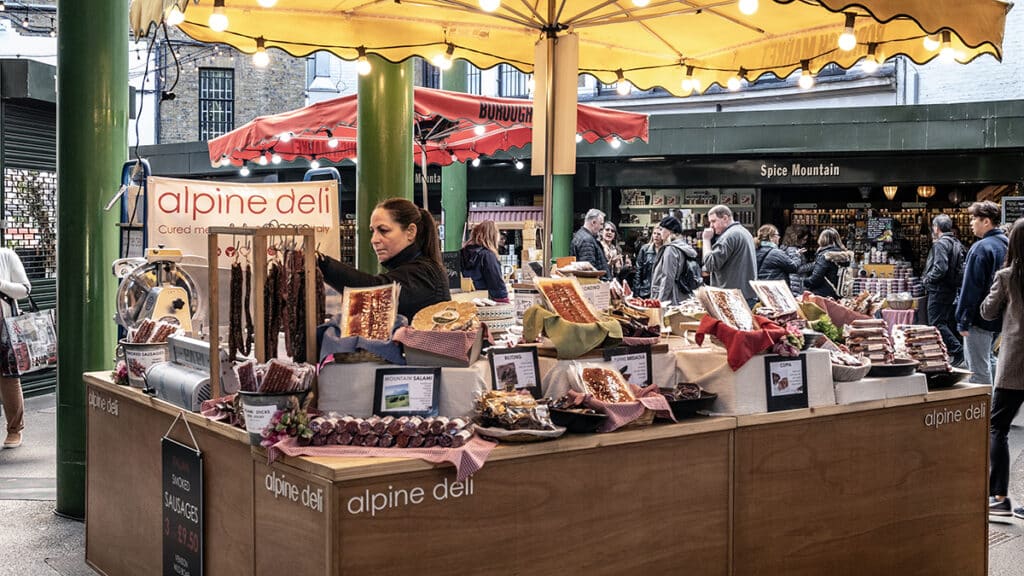
CROATIA
Kozlović Malvazija white wine from Taste Croatia
A crisp, zesty, mineral-rich white wine produced by the Kozlović family in the Valle valley, in the Istria region of Croatia, an underappreciated winemaking heartland.
DENMARK
Gravadlax from Shellseekers Fish & Game
A Nordic classic made with salmon from the Faroe Islands. But the Faroe Islands aren’t in Eurovision, we hear you say. True. But the archipelago is part of the Kingdom of Denmark – so it still counts.
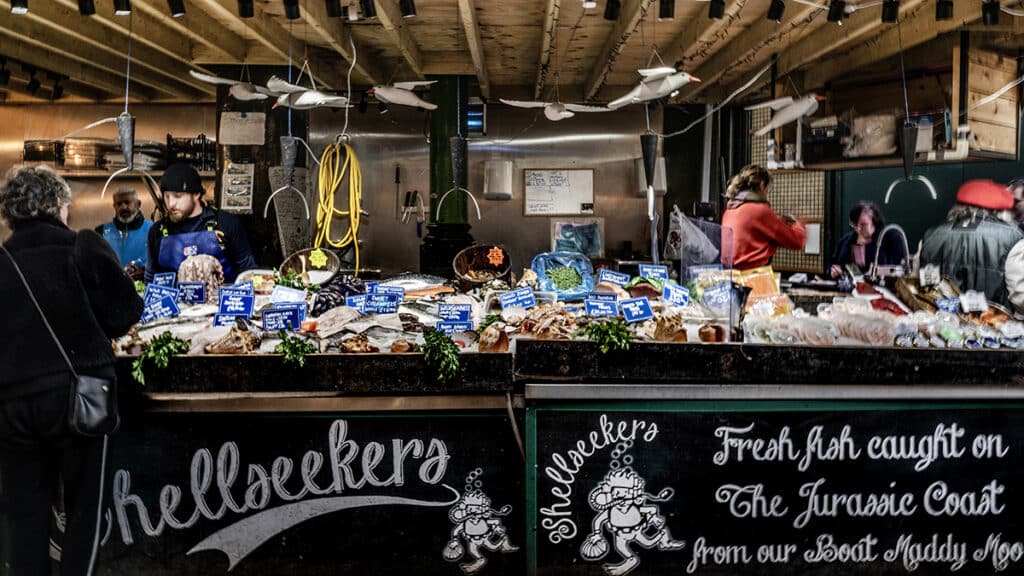
ESTONIA
Põhjala beers from Utobeer
A range of consistently excellent beers created in Tallinn, Estonia at a brewery founded in 2011 by four local beer enthusiasts. Easy to drink, but not – to a non-Estonian – quite so easy to say.
FRANCE
Camembert Fribois from Une Normande a Londres
This gooey, full-flavoured, raw milk camembert is made in Saint-Loup de Fribois, Normandy. A cheese as salty and enjoyable as Graham Norton’s commentary.
GERMANY
Pretzels from Artisan Foods
Germany consistently underperforms at Eurovision comparative to its size and influence, but its pretzels are born winners. These big pillowy bows are both soft and salty. Perfect with a beer.

GREECE
Amfissa green olives from Oliveology
Exceptional handpicked olives from the Atrapos Farm, an organic and biodynamic farm in central Greece, pickled with herbs. Firm, green flesh; fresh, bright taste.
IRELAND
Gubbeen from Neal’s Yard Dairy
“Bouncy, unctuous and smooth” is how Neal’s Yard Dairy describes this beautiful brine-washed cheese from County Cork. Throw in “cheesy” and you’d have a perfect description of most Eurovision songs too.
ISRAEL
Babka from Shuk
As sweet and satisfying as a 12-point score, these braided Israeli-style bakes are filled with rich hazelnut and dark, sticky chocolate.
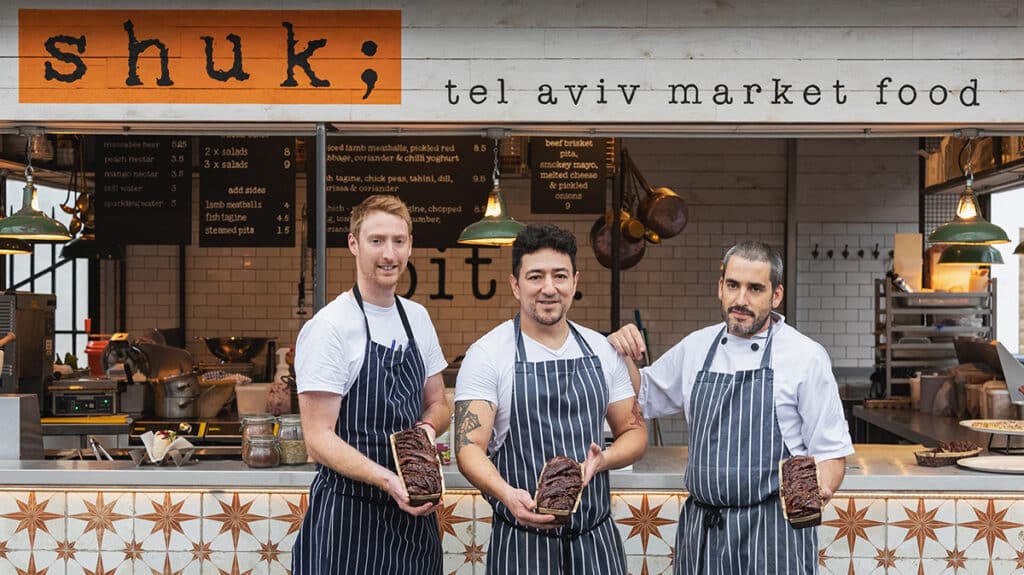
ITALY
Red Cow parmesan from Bianca Mora
The finest Parmigiano Reggiano, made from the milk of Vacche Rosse cattle. Has won more Slow Food awards over the years than fiddle-infused Irish ballads have won Eurovision. And that’s a lot.
NETHERLANDS
Oude Beemster Gouda from Borough Cheese Company
The Dutchest of Dutch cheeses. Not only is it the platonic ideal of a buttery, fudgy, crystal-flecked gouda, the defining cheese of the Netherlands, it’s also orange.
PORTUGAL
Pinhais sardines in olive oil, ‘millésime’ edition, from The Tinned Fish Market
Like a UK entry that doesn’t completely tank, the millésime (‘vintage’) version of these Portuguese sardines isn’t something you’ll see every year – only when the fat ratio and size of the fish are up to scratch.
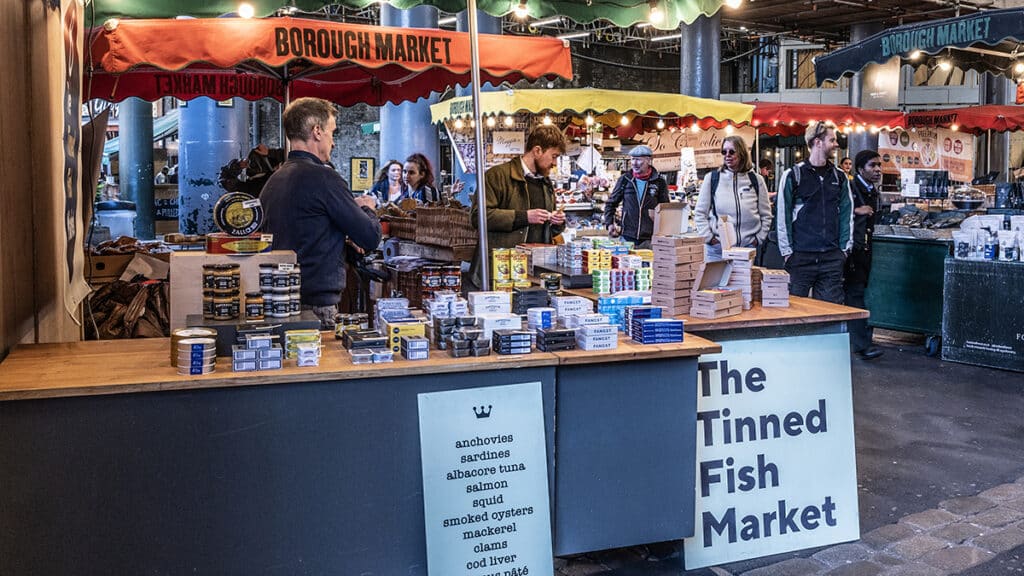
SPAIN
El Artesano Raúl Valcarce bittersweet figs from Brindisa
These green figs are picked while still firm, then marinated in vinegar, sugar and spices. A delicious accompaniment to a plate of hard cheeses and cured meats. As bittersweet as a Julio Iglesias croon.
SWEDEN
Brännland Claim Iscider from The Cider House
If Sweden win on Saturday – and they’re favourites to do so – this is the drink to toast their victory. It’s the cider equivalent of an ice wine, made after the winter cold has intensified the sweetness of the apples.
SWITZERLAND
Young Emmental from Jumi Cheese
Elastic in texture, mild but complex in flavour and marked by large holes. Probably the most recognisably Swiss foodstuff and a potential winner of whatever the cheese equivalent of Eurovision might be.
UK
Melton Mowbray pork pie from Mrs Kings Pork Pies
An east Midlands classic that’s been produced in Melton Mowbray under the Mrs Kings name since the 1853 edition of Eurovision, won by a controversially up-tempo waltz from the Austrian Empire.
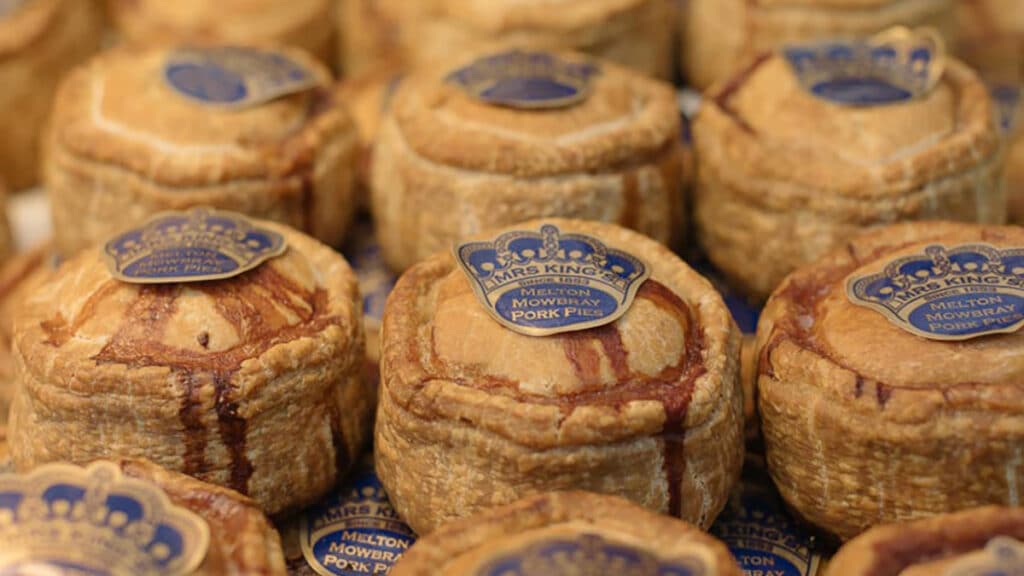
DISCOVER MORE
Crowning glory
Mark Riddaway tells the story of coronation chicken
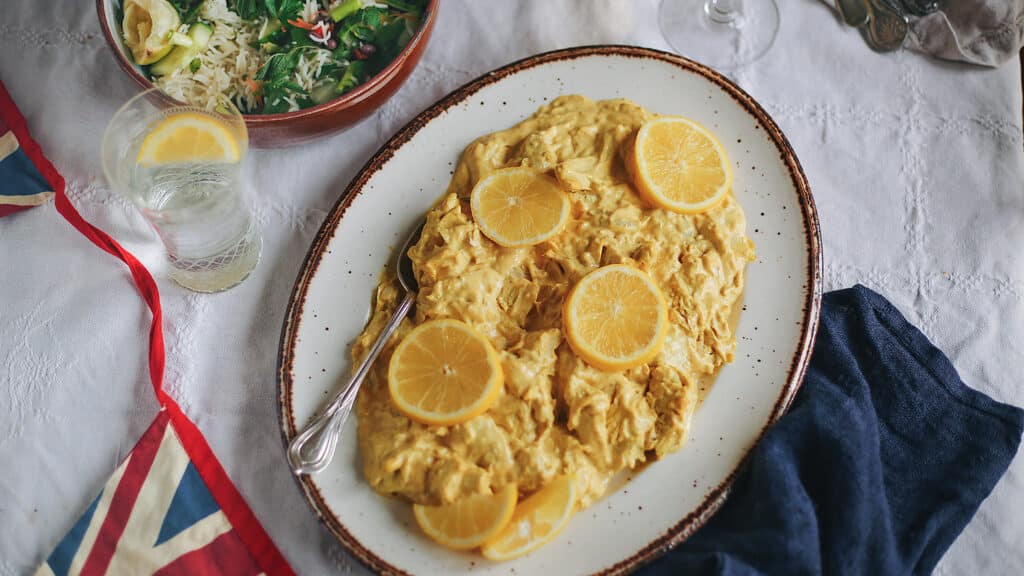

“BACK IN THE 1950S CHICKEN WAS STILL CONSIDERED A LUXURY MEAT, LARGELY RESERVED FOR THE TABLES OF THE WEALTHY”
Image: Jenna Roberts (@JennaFifi)
When Edward VII came to the throne in 1902, a Lincolnshire farmer decided to honour the new monarch by giving his name to a new breed of potato – the King Edward – which went on to become one of the great staples of British cookery, a source of some of the very best roasties you’ll ever eat. Half a century later, his great-granddaughter Queen Elizabeth II had a similarly indirect influence upon British cuisine when her coronation inspired the creation of one of the nation’s most misunderstood sandwich fillings: coronation chicken.
That such an auspicious occasion should result in so seemingly prosaic a dish was, in a way, entirely fitting. The Queen’s coronation ceremony took place on 2nd June 1953, and despite being a triumphant affair, the events of that day carried a distinct air of post-war austerity. The official banquet at Buckingham Palace involved a restrained four-course meal – a starter of chicken consommé, a main course of filet de boeuf mascotte (fillet of beef with artichokes, cocotte potatoes and truffle), a salad, and a simple dessert of mango ice cream.
To put this in context, at James II’s coronation in 1685 the first course alone consisted of 46 different dishes, brought into Westminster Hall by a procession of 73 people, including three on horseback. At Henry VI’s coronation in 1429, the menu included boars’ heads “in castles armed with gold”, a roasted peacock that had been painstakingly stuffed back into its own skin and feathers, a fritter “like the sun”, and a jelly illustrated with “the writing and musical notation of Te Deum Laudamus”. Henry himself was still a month short of his eighth birthday and would probably have been perfectly happy with a nice cake.
Coronation chicken was invented not for the main banquet, as is often stated, but for a lunchtime function attended by several hundred foreign dignitaries who were in London for the celebrations. The dish tends to be attributed to the celebrity florist, interior designer and general domestic goddess Constance Spry, who was responsible for the flower arrangements at the coronation, and its recipe was published for the first time in 1956 in The Constance Spry Cookery Book – a vast, 1,000-plus-page masterpiece of 1950s home economics. In reality, coronation chicken (like most of the dishes in Spry’s book) was created by the florist’s friend and close collaborator Rosemary Hume. Hume was a respected chef who had founded the L’Ecole du Petit Cordon Bleu cookery school in Victoria in 1933. In 1946 Hume and Spry joined forces to open a domestic science school in Winkfield Place, Berkshire, and when the college’s students were asked to cater for the coronation lunch, Hume set about inventing a new dish for them to serve.
These days, we expect coronation chicken to be a vivid yellow gloop, sweet with sultanas and lumps of fruit and spicy with curry sauce. But Hume’s original dish, as is to be expected from a woman who trained in Paris under the classical culinary master Henri-Paul Pellaprat, was very different to the oozing sandwich filling that would come to take its name. This was a subtle, creamy concoction, delicate in flavour and created with not a single sultana in sight. It was designed to be served with a rice salad rather than splodged between slices of bread.
Most of what you need to recreate Hume’s version can be bought at Borough Market. It all begins with the chicken, of course, which back in the 1950s was still considered a luxury meat, largely reserved for the tables of the wealthy. You’ll be able to buy suitably regal, slow-growing breeds at any of the Market’s butchers, all of them packed with the deep flavours such birds were valued for in the days before battery cages, high-protein feeds and intensive drug regimes turned chicken into a cheap, bland and ethically questionable staple.
Exactly what the Queen thought of coronation chicken was not a matter of public record. One thing is certain, though: it’s an easier dish to produce at home than re-stuffed peacock.
Mark Riddaway is the author of Borough Market: Edible Histories (Hodder & Stoughton)
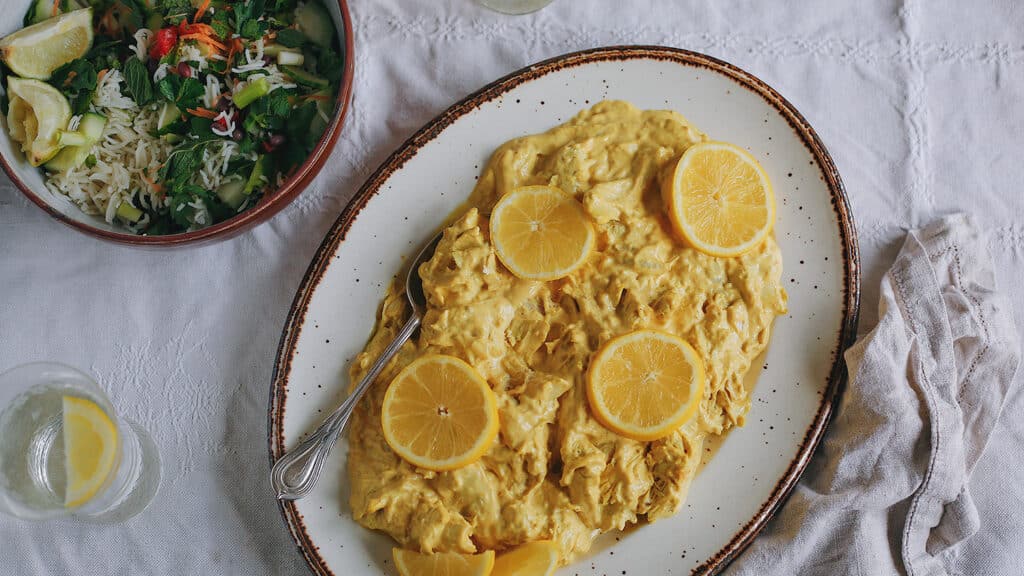
Fit for a King
Eight ways to mark the coronation at Borough Market


“AT BOROUGH MARKET, KING CHARLES IS JUST A FOOD OBSESSIVE, CHATTING TO HIS FELLOW FOOD OBSESSIVES”
1. Support small, sustainable food producers
One of the hardest things about being the British monarch must be how tight-lipped you’re expected to remain on any topic deemed even vaguely political. And it must be particularly difficult if you have as many impassioned opinions as King Charles III.
Thankfully for him – and us – his time as Prince of Wales afforded Charles the opportunity to enjoy several decades as an outspoken participant in the public forum before the protocols of monarchy kicked in. Through his speeches, articles, interviews and letters to ministers, we know a lot about his thoughts and passions, which cover a wide range of topics – architecture, conservation, education, medicine. And one of the subjects he’s had most to say about is sustainable food production.
Take this statement from 2021: “To me, it is essential that the contribution of the small-scale family farmer is properly recognised – they must be a key part in any fair, inclusive, equitable and just transition to a sustainable future. To do this, we must ensure that Britain’s family farmers have the tools and the confidence to meet the rapid transition to regenerative farming systems that our planet demands.” That could very easily be a direct quote from the Borough Market Food Policy.
Or this from 2019. We should, he said, be celebrating “products that tell a really good story, emphasise the importance of native breeds, support family farms and put soil health and fertility at the centre of the entire process”. It’s a description that fits so much of what Borough Market sells, from the unpasteurised Sussex milk of Hook & Son to the colourful chard of Hickson & Daughter, to the cured meats sourced from small Italian producers by The Parma Ham & Mozzarella Stand.
2. Chat to a trader
It’s because of this sense of alignment with the values of Borough’s traders that the new King and Queen have been regular visitors to the Market. They were our guests of honour in November 2005, marking the 250th anniversary of Borough Market’s current incarnation. They returned in February 2013 when the magnificent new Three Crown Square hall was re-opened after years of building work on the overhead viaduct. They were here again in December 2017 to show their support in the aftermath of the terror attack. On each occasion they spent several hours talking, shaking hands and tasting eagerly presented samples. Nothing about the royal couple’s engagement with the traders, their stories and their products felt cursory or staged. Here, Charles is just a food obsessive, chatting to his fellow food obsessives.
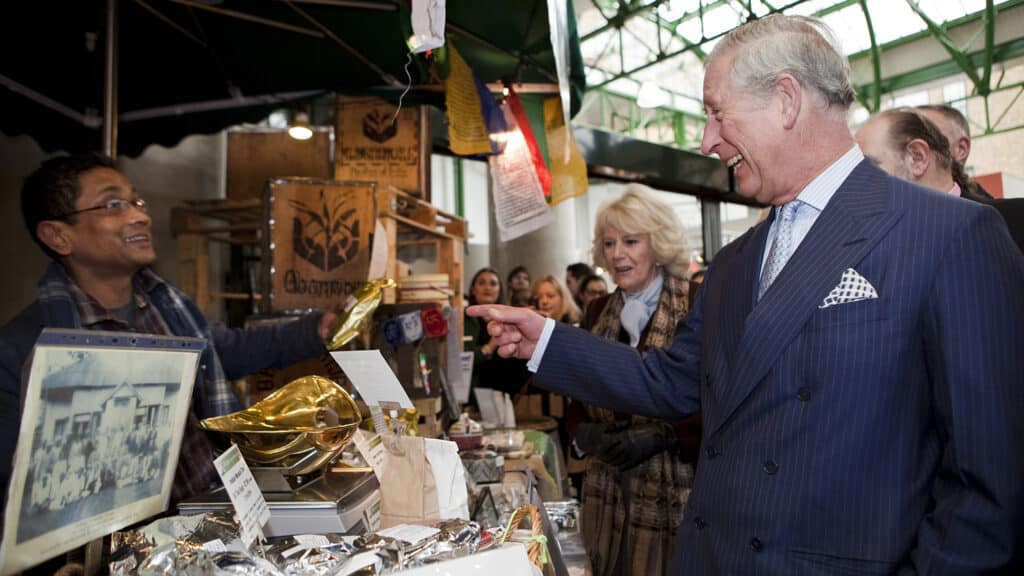
3. Examine some architecture
The King loves architecture. Or at least some architecture: the historic type. Borough Market is full of plenty of that: a mélange of eras and styles from the past two centuries or so. There’s the beautifully ornate Floral Hall portico, which was built beside Covent Garden market in the 1850s and transposed to Borough less than 20 years ago but looks as though it’s been here forever. There are the striking Art Deco gates on the high street, which were first opened in 1933. There are even nine bollards and a lamp post in the Green Market, all of which have a Grade II listing from Historic England. Come for the incredible food, stay for the bollards.
4. Enjoy a taste of the West Country
“I have put my heart and soul into Highgrove,” the King has said of Duchy Home Farm, his organic farm on the Highgrove estate. “All the things I have tried to do in this small corner of Gloucestershire have been the physical expression of a personal philosophy.” As a West Country farmer, he’s always been active in promoting the region’s culinary gems. Borough Market is home to many of these: the cured meats of Capreolus, the cheeses of Bath Soft Cheese and Trethowan Brothers, the seafood and venison of Shellseekers Fish & Game, and the meat and other local produce sold at Wild Beef.
5. Buy some rare breed meat
When you read through his long list of food-related patronages, it’s clear that one of the King’s abiding passions is rare breed farm animals: the traditional, slow-growing, regionally distinctive breeds that were almost wiped out during the 20th century rush to engineer bigger, meatier, blander-tasting animals that reach maturity much more quickly. As well as being patron of the Rare Breed Survival Trust, he lends his support to just about every breeders’ association working to sustain our native livestock. Borough Market is a haven for these delicious traditional meats. Among many others, you’ll find Welsh Black and Devon cattle at Wild Beef, White Park cattle and Hampshire Down sheep at Northfield Farm, and Lincoln Red cattle and Tamworth pigs at Ginger Pig.
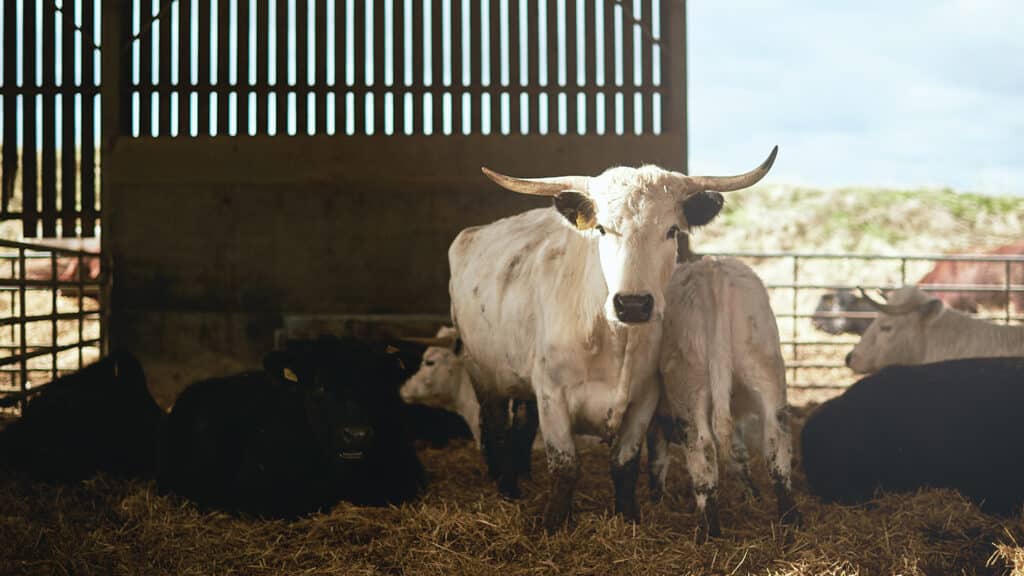
6. Volunteer for Plan Zheroes
One of the major themes of the coronation is a drive to encourage people to volunteer in their communities. If you’d like to make a difference, we have a great option. Twice a week, the Plan Zheroes organisation collects surplus food from our traders. This food, no longer perfect but still good to eat, is given to more than 20 charities to help feed vulnerable people across London. Plan Zheroes relies on volunteers. If you’d like to help combat food waste while supporting your fellow Londoners, sign up now.
7. Explore the flavours of the Commonwealth
Across much of the Commonwealth, important discussions are currently taking place about the inseparable ties between monarchy and colonialism and whether to follow the likes of Barbados and Trinidad in embracing a republican future. But for now at least, King Charles is head of state of 15 countries spanning the globe. As a result, this year’s coronation is an event whose significance reaches far beyond these shores. Borough Market has two stalls that bring some of the flavours of the Commonwealth to London. Doreen at De La Grenade imports beautiful jams, jellies and pepper sauces from Grenada, a Caribbean island famous for its nutmeg and mace, while the sauces, seasonings, chutneys and dressings at Dawn Smith’s Pimento Hill stand provide a vivid taste of Jamaica.

8. Pick up a tea towel
At times of great ceremonial importance, what is it that we do as a nation? We buy commemorative tea towels. Head to The Borough Market Store for a classic example of the genre.
Five gluten-free grains
Caroline Aherne, founder of The Free From Bakehouse, on her go-to grains for wheat-free baking


“THE BEST INGREDIENTS ARE THOSE WITH STRUCTURAL PROTEIN THAT CAN WORK IN A SIMILAR WAY TO GLUTEN”
Although no single alternative will ever fully replace wheat flour, there is an alchemy to creating flavoursome, gluten-free bakes using a combination of different grains. The best ingredients are those with structural protein that can work in a similar way to gluten by binding the mix together.
Sorghum
An important flour for gluten-free baking on account of its high protein and fibre content, and its sweet flavour. When mixed with a couple of other flours, sorghum is particularly good for light bakes.
Teff
Used in Ethiopian cuisine to make injera, the country’s staple flatbread, teff is available in dark and light versions. The light version is good in cakes, such as victoria sponges. The dark version works in crackers, biscuits and pastry.
Rice flours
Brown rice flour, which is bland and has a slightly gritty texture, is a staple base flour. White rice flour has higher levels of starch and works extremely well in flour mixes, as it not only aids the binding process but also holds in moisture.
Buckwheat
Buckwheat isn’t actually wheat – it comes from the rhubarb family. It has a nutty, slightly bitter flavour and a high protein content. In France, it’s popular in savoury pancakes called galettes, and in biscuits. Make sure you’re buying certified gluten-free buckwheat.
Oat flour
Oat flour is a great source of protein and fibre. When fine, it adds a softness to bread dough; when not so fine, it produces a really good texture in biscuits. Look for certified gluten-free oat flour or else buy porridge or whole oats that you can grind yourself.
From Borough Market: The Knowledge with Angela Clutton (Hodder & Stoughton 2022)
Raw potential
Steve Hook of Hook & Son on the benefits and challenges of producing unpasteurised milk
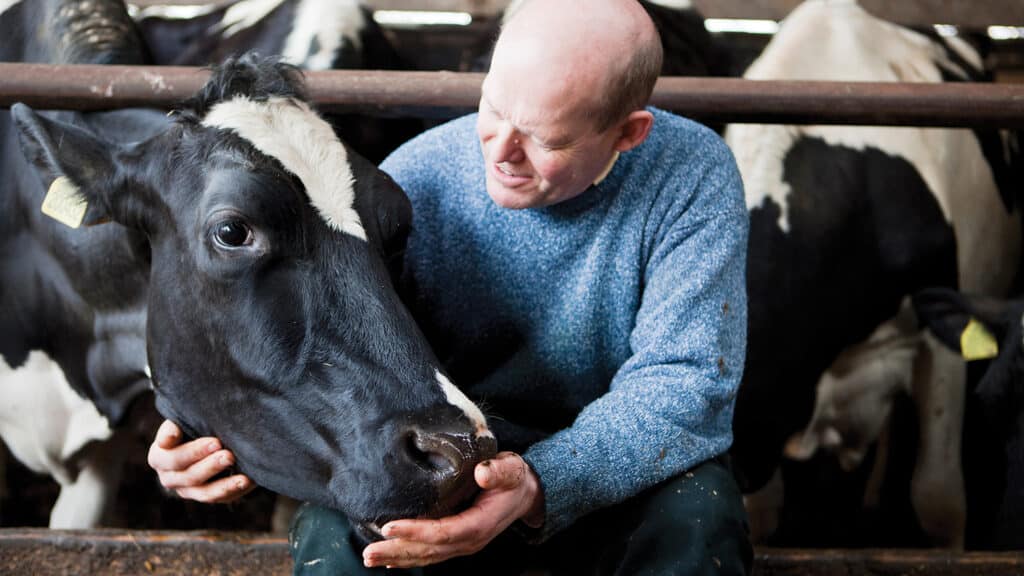

“WHEN PRODUCED BY RESPONSIBLE FARMERS, RAW MILK CAN BE A COMPLETELY SAFE AND HIGHLY NUTRITIOUS PRODUCT”
Interview: Viel Richardson / Images: Joseph Fox
“I just think it’s better milk,” says Steve Hook, owner of Hook & Son, describing the unpasteurised, unhomogenised milk he produces at a small dairy farm on the edge of the Pevensey Levels in Sussex and is now selling from an impressive new stand in Borough Market’s Three Crown Square. Having built a loyal following among Borough customers over many years, Steve’s business has moved to a bigger space to accommodate a larger range of his farm’s products. These include milk, butter, buttermilk, ghee, cream, crème fraiche, yoghurt and – for the first time at the Market – dairy beef and rose veal from his single herd of pasture-fed cattle. Milk may be the farm’s primary product, but the range is designed to ensure that as little as possible is wasted from the lifecycle of the animals.
Steve argues that his raw milk has a richness and depth of flavour far removed from the pasteurised milk found in supermarkets – a reflection of the natural diet eaten by his herd. His cows roam on wild meadows, rushes and marshes and choose what they want to eat, and their varied and highly localised diet is reflected in the distinctive flavour of the milk, which changes with the seasons. This offers a stark contrast to industrially produced milk, which comes from multiple cows from multiple herds that have been fed a diet of soy and grains designed to maximise yields and in which even the slightest hint of character is quickly killed by pasteurisation (sterilising by heating) and homogenisation (breaking down the milk’s fats through mechanical processing).
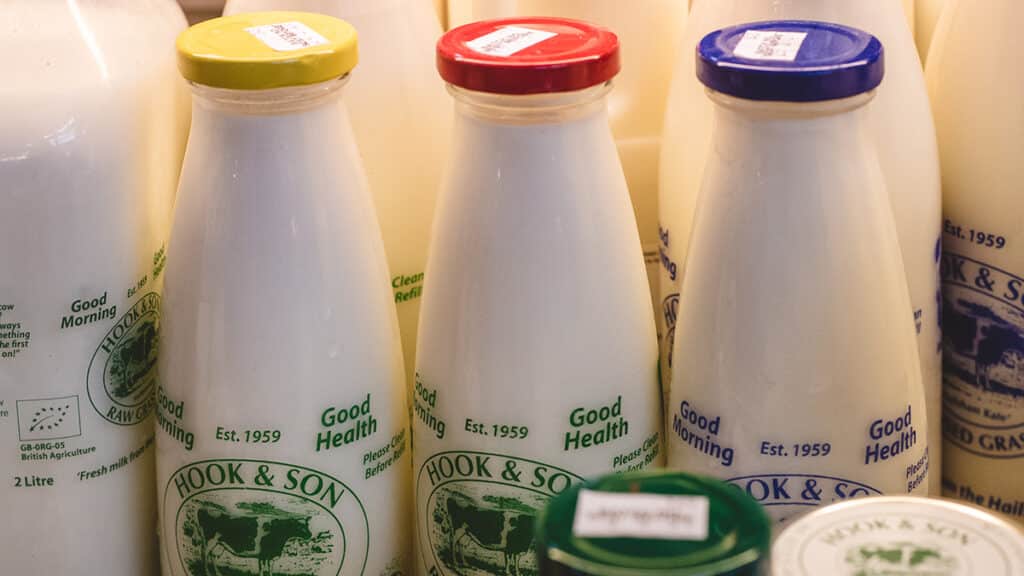
“We’ve always drunk raw milk from our farm,” he says, “although the thought of selling it didn’t occur to me until the price we were being offered for pasteurised milk fell so low you just couldn’t make a living.” The problem with selling raw milk is that, for historical reasons, it is one of the country’s most arduously regulated foodstuffs. Over the years, Steve’s decision to do so has resulted in surprise inspections, legal battles and even undercover officers filming his retail sites.
Pasteurisation was made mandatory in the UK in 1924, when a significant proportion of commercially produced milk had become too risky to drink. The problem was twofold: milk from dairy herds infected with tuberculosis or brucellosis could pass the diseases on to people, with devastating consequences, while bad practice and poor hygiene during milk storage and transport allowed the development of other dangerous bacteria such as salmonella, E. coli and campylobacter. But although pasteurisation has undoubtedly saved many lived, it destroys much of the milk’s flavour, and kills all the good bacteria too.
When produced by responsible farmers, raw milk can, Steve insists, be a completely safe and highly nutritious product. “The problems are caused by poor farming practises and bad milk handling processes, both of which are entirely solvable without pasteurisation,” he explains. “Our herd, for example, was established in 1959 and has always been clear of TB and brucellosis. Our cows are milked in extremely hygienic environments using advanced milking equipment that is kept sterile. We also pay fantastic attention to hygiene throughout our milking and milk handling processes. This means we easily pass the stringent plant inspections and bacteriological tests regularly conducted by the Food Standards Agency. In this way, our milk retains all the benefits of the good bacteria, without the risk of encountering the bad.”
By law, raw milk can only be bought directly from the farmer who produced it. More and more people are now discovering the joys of doing so. “Our first milk round selling raw milk was 12 litres delivered in my dad’s Volvo estate to local customers. I think on the UK about 300,000 litres of raw milk a year were sold,” Steve says with a smile. “Now there are over 200 farmers selling three million litres a year to the public.” With his milk now sold from a big stand in a prominent position in the country’s best food market, that figure is only going to rise.
Seven steps to waste-reduction heaven
Martyn Odell, the TikTok star known as Lagom Chef, provides his top tips for cutting down on food waste
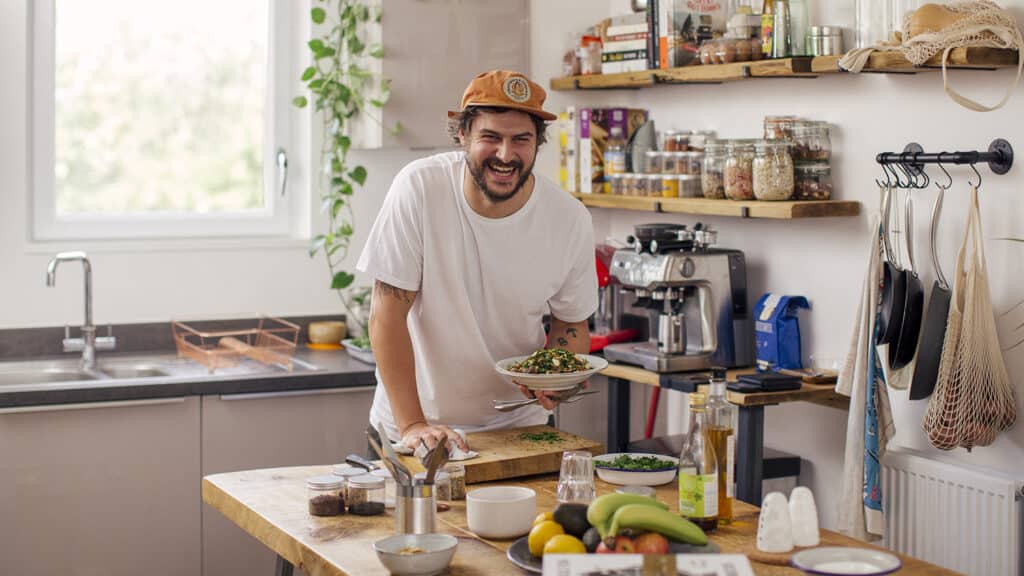

“ONE OF THE GREAT THINGS ABOUT SHOPPING AT A FOOD MARKET IS THAT IT’S EASY TO BUY THE EXACT QUANTITY YOU NEED”
If you love cooking and you’re on TikTok, there’s every chance you’ve already found yourself hypnotised by Lagom Chef and his high-energy mission to keep good food from being thrown away. For the uninitiated, Martyn Odell – as he’s known in real life – is a self-described ‘food waste disruptor’ who’s been harnessing the extraordinary power of social media to help millions of people save money and reduce their environmental impact. With an approach that favours fun and creativity over po-faced moralising, his videos provide flavour-packed recipes and practical advice, all of which result in a full stomach and an empty bin.
When Martyn joined us to record a special episode of the Borough Talks podcast, alongside fellow campaigner Chloë Stewart of nibs etc., we asked him to provide his top tips for reducing food waste.
Here’s what he told us:
1. Think of your kitchen cupboards as a dry store where you keep all the ingredients that are the backbone of the meals you make. We’re talking tinned foods, pulses, grains, pasta and rice. A few key herbs and spices. Then, you have the basis of a huge range of nutritious, home-cooked meals and can add in fresh ingredients as and when you need them. Not only is it economical but reduces waste in a huge way.
2. If you’re tight on storage space, stick to some key flavourings to pep up your cooking. My top suggestions for a super-versatile spice cupboard with maximum flavour are smoked paprika, cumin seeds, coriander seeds, Aleppo pepper, fennel seeds and smoked salt. Flavour-packed store cupboard heroes like miso, different vinegars, gochujang and harissa also give you an incredible jump-off point for a recipe.
3. Don’t feel pressure to fill your fridge with loads and loads of fresh ingredients. Try to only buy what you need. One of the great things about shopping at a food market is that buying the exact quantity you need is much easier, as very little of the produce is pre-packaged. If all you need is a single egg or a one small onion, someone will sell them to you.
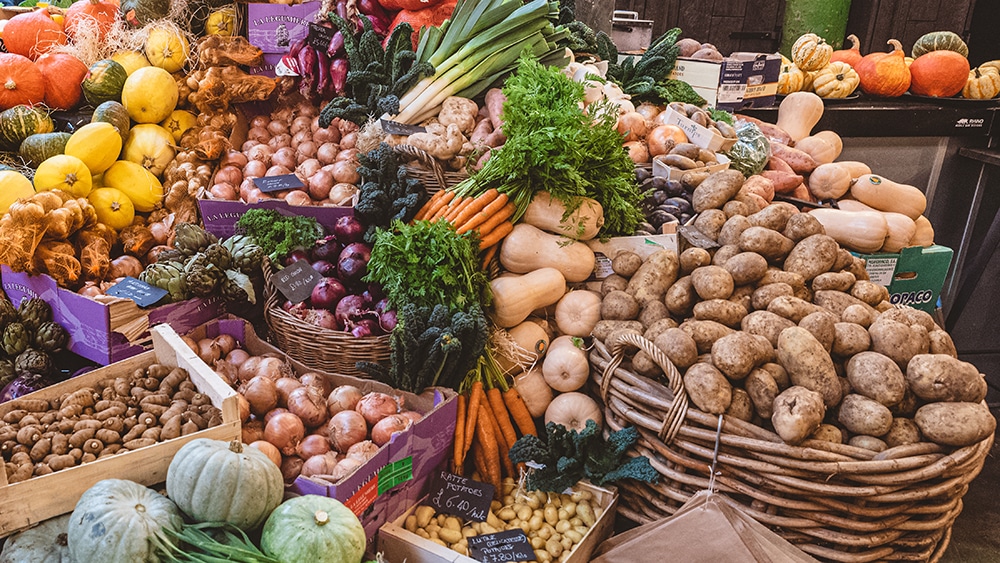
4. If you have a surplus of fresh ingredients in your salad drawer, don’t panic! You can usually turn it into something that will be an incredible versatile base to freeze. For example, if you have loads of tomatoes, cook them down into a really intense tomato sauce. Add in any combination of grated veggies and you’ve got a great base to make a whole range of meals including shakshuka, soups, stews or curries.
5. You can freeze more than you think. Grated ginger freezes really well, as do yoghurt, milk and bread.
6. Ask the experts. Traders at Borough Market know better than anyone how much you need to buy, how soon their produce needs eating and what to do with it once it’s a little bit past its best, so don’t be shy about picking their brains.
7. And finally, enjoy the process of cooking and eat what you love.
BOROUGH TALKS: FOOD WASTE SPECIAL
Chloë Stewart of nibs etc. and TikTok star Martin Odell on the devastating impact of food waste and how, by unlocking creativity and changing our habits, we can all play a part in reducing it.

Women of Borough Market: Thea
To mark International Women’s Day, some of Borough Market’s female traders, staff and trustees share their experiences as women in the food industry. Today, Thea Wunderer of Alpine Deli on market trading, female charcuterie lovers and the changing face of butchery
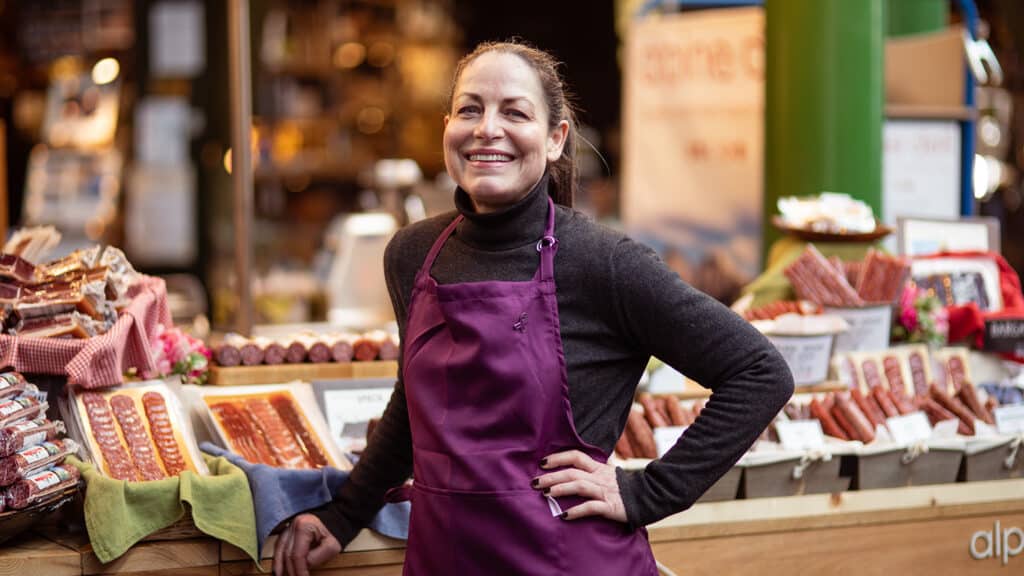

“I THINK THIS IDEA THAT CURED MEAT IS A MASCULINE FOOD IS A PERCEPTION THAT ISN’T TRUE ANYMORE”
Interview: Clare Finney
I had always thought of charcuterie as being something that men were more likely to be drawn towards, but I’m not so sure that’s the case these days. I think this idea that cured meat is a masculine food is a perception that isn’t true anymore. At Alpine Deli, there are so many female customers who love cured meat and buy it for themselves, not for their husbands or boyfriends – and I love to see that.
In fact, I think the gender balance of my customers at Borough Market is pretty even. That is also completely normal in Spain and France – and Italy, where I come from. I grew up with cured meat products. The hams, salamis and sausages I sell are all from my hometown in South Tyrol, in the far north of Italy. My dad was a farmer and had a restaurant in the village, so I’ve always been close to the food industry. One thing led to another, and in time I ended up bringing produce from back home to sell here in London.
My customers are very mixed, but the making of charcuterie does remain male-dominated. That is slowly changing, though. I find there are more and more female butchers. Just look at Wyndham House Poultry in the Market, which is mostly female, and at Ginger Pig – there are female butchers there, too. There is no reason why that shouldn’t be the case. Meat can be interesting to anyone; it is life, after all.
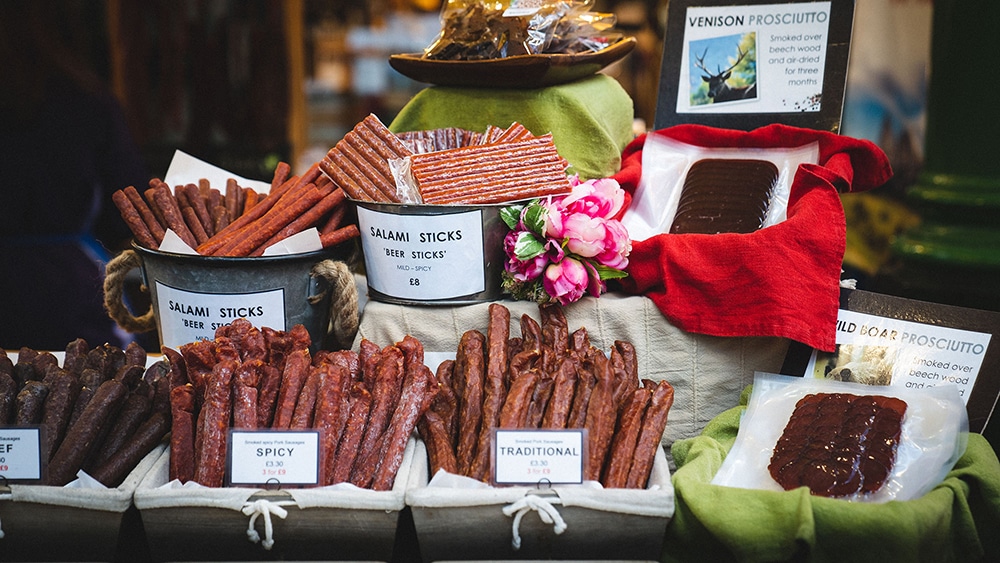
As for the world of being a market trader, I don’t think that’s a particularly male or female thing. There are loads of women working at Borough Market now, selling brilliant produce. I certainly wouldn’t say I’ve faced more challenges on account of being female. The job itself is tough, regardless of who you are and what you’re selling. You have to be quick and resilient to deal with different people and different situations. If something breaks, you have to know how to fix it, or find a solution to quickly replace it. It’s physically tough, setting up the stall and being on your feet all day. And let’s not forget the weather conditions: the cold, the wind and the rain.
I’ve been at Borough Market for 13 years now, and every year I’ve found myself with more customers and more regulars. Maybe it’s a me thing, maybe it’s a woman thing, I don’t know, but I see this as me doing something I’m passionate about, and I think that’s the reason I’ve been successful. I’ve put everything into it and I’m always here, so I’m a familiar face. That said, I’ve been very lucky in having a lot of support. I would not have been able to do this on my own, without the people around me. I was a girl from the Italian mountains, coming to a big city in a different country. Step by step, with plenty of encouragement, I’ve achieved something I’m proud of.
